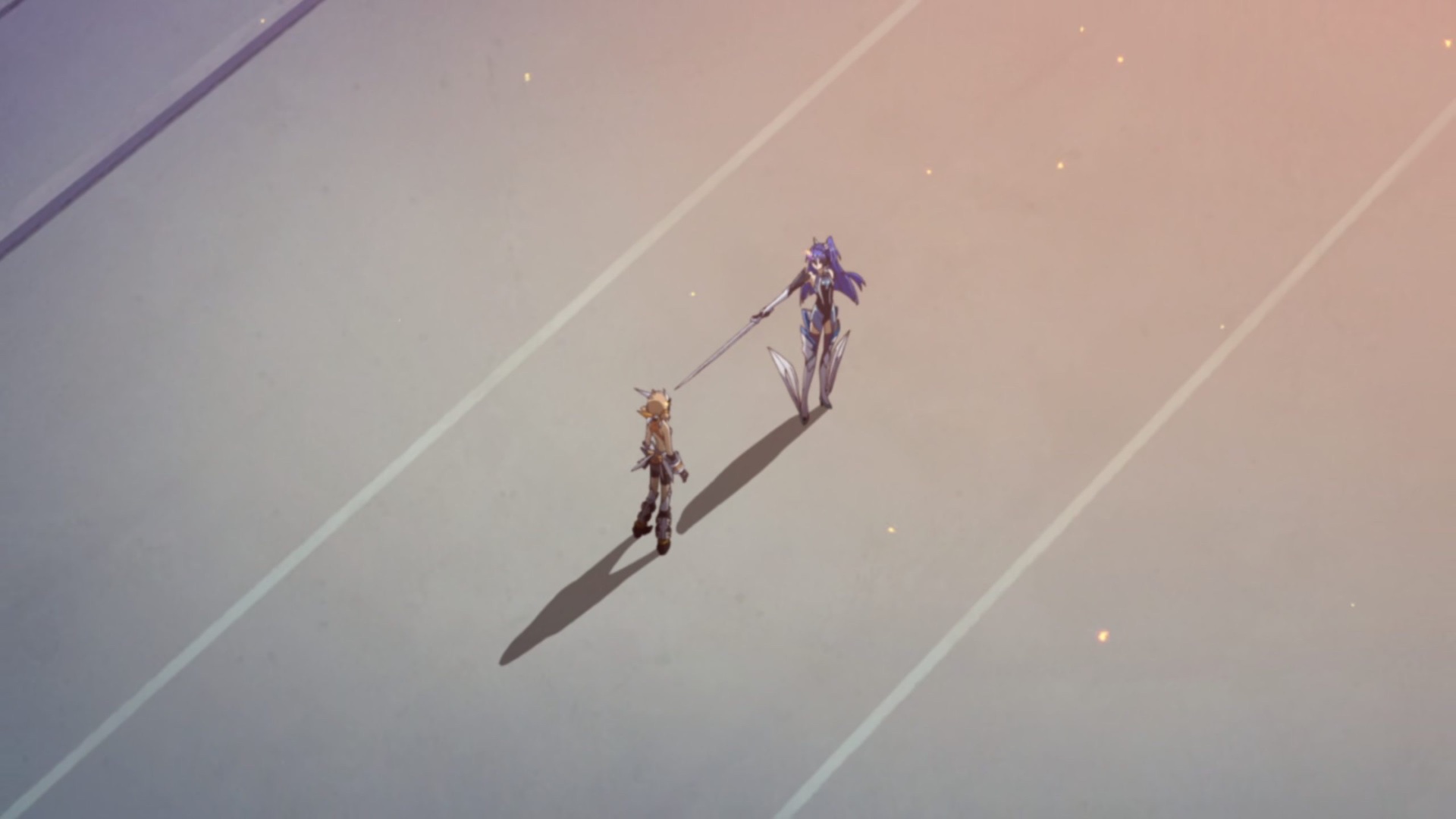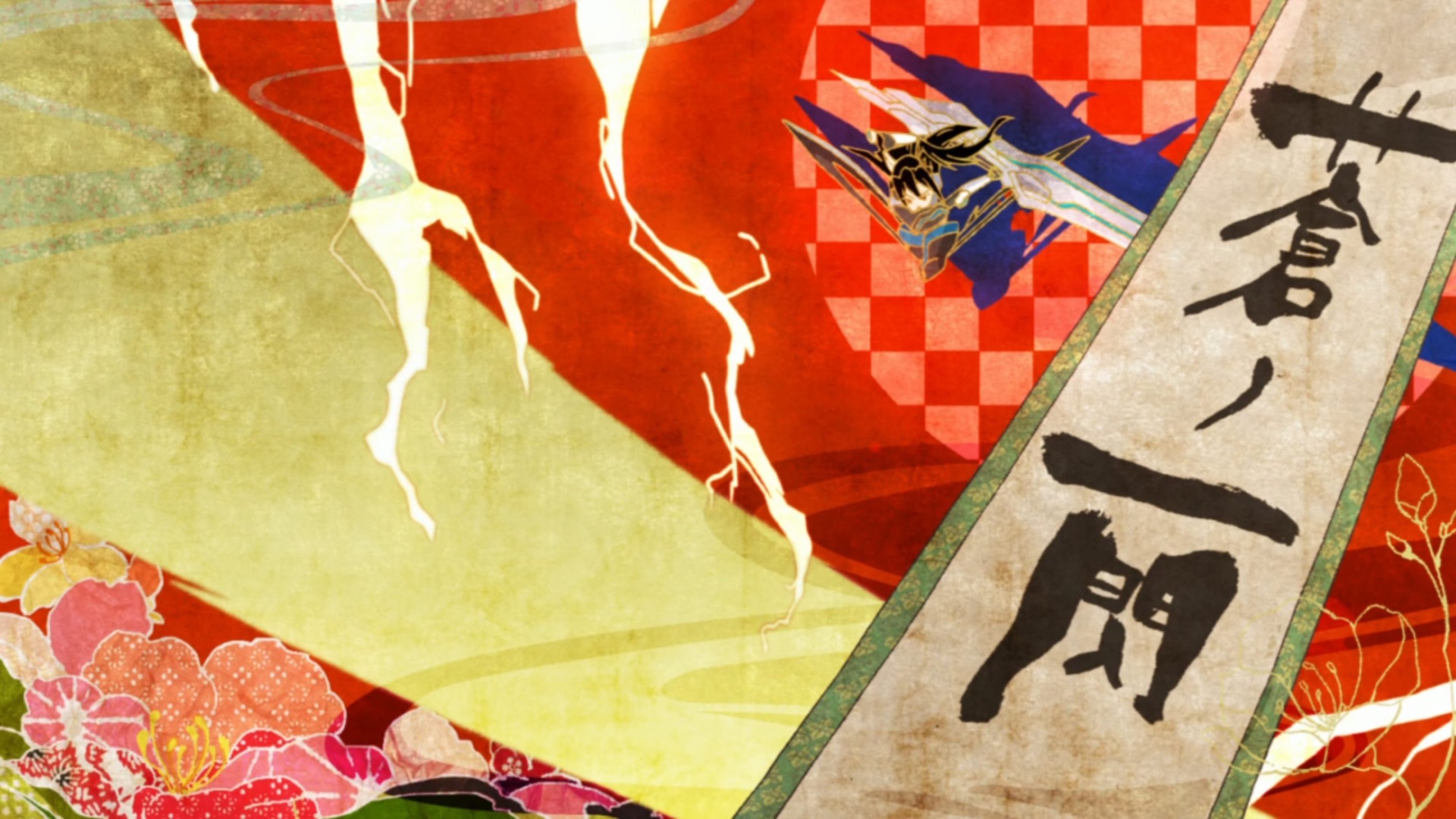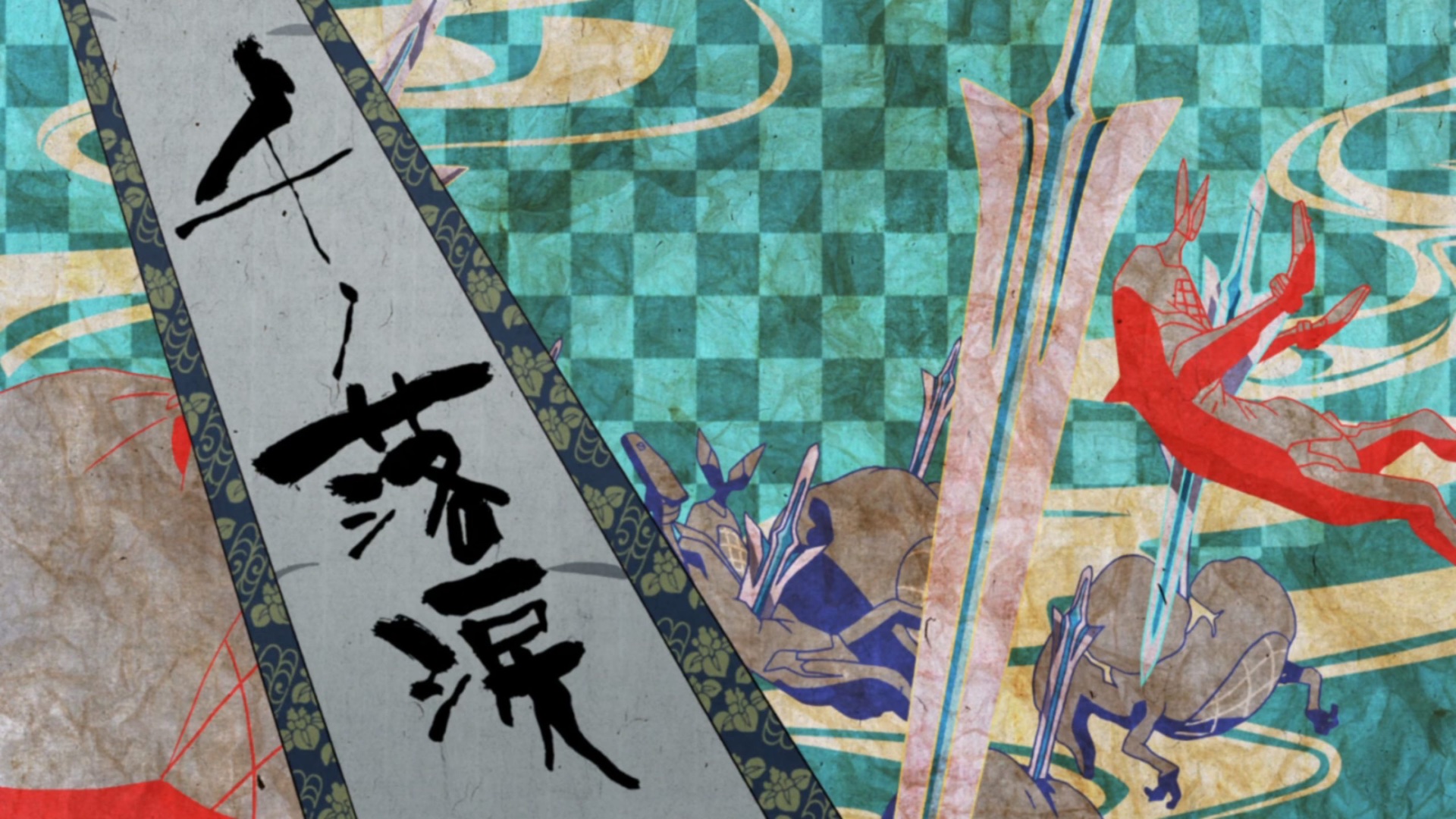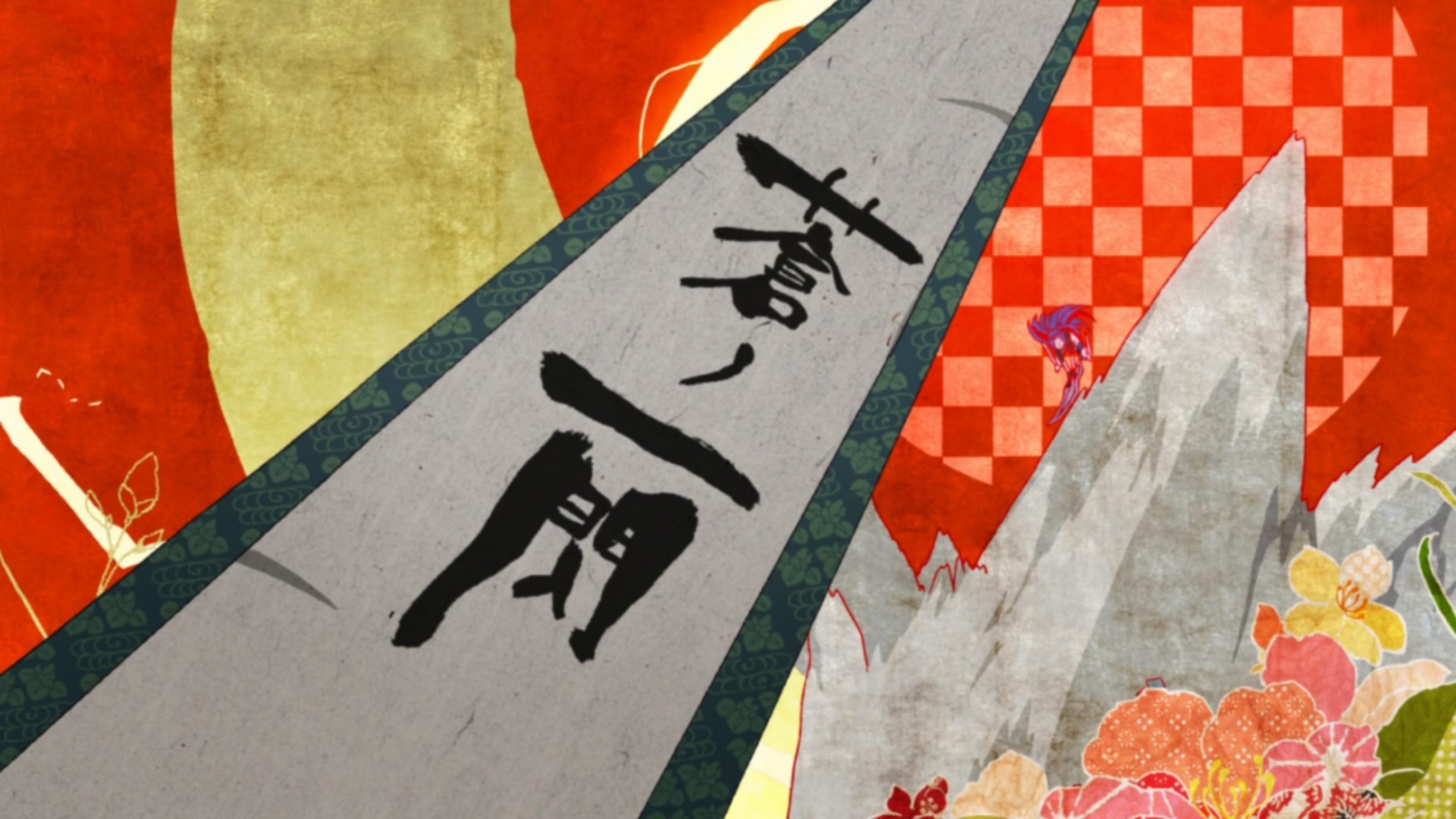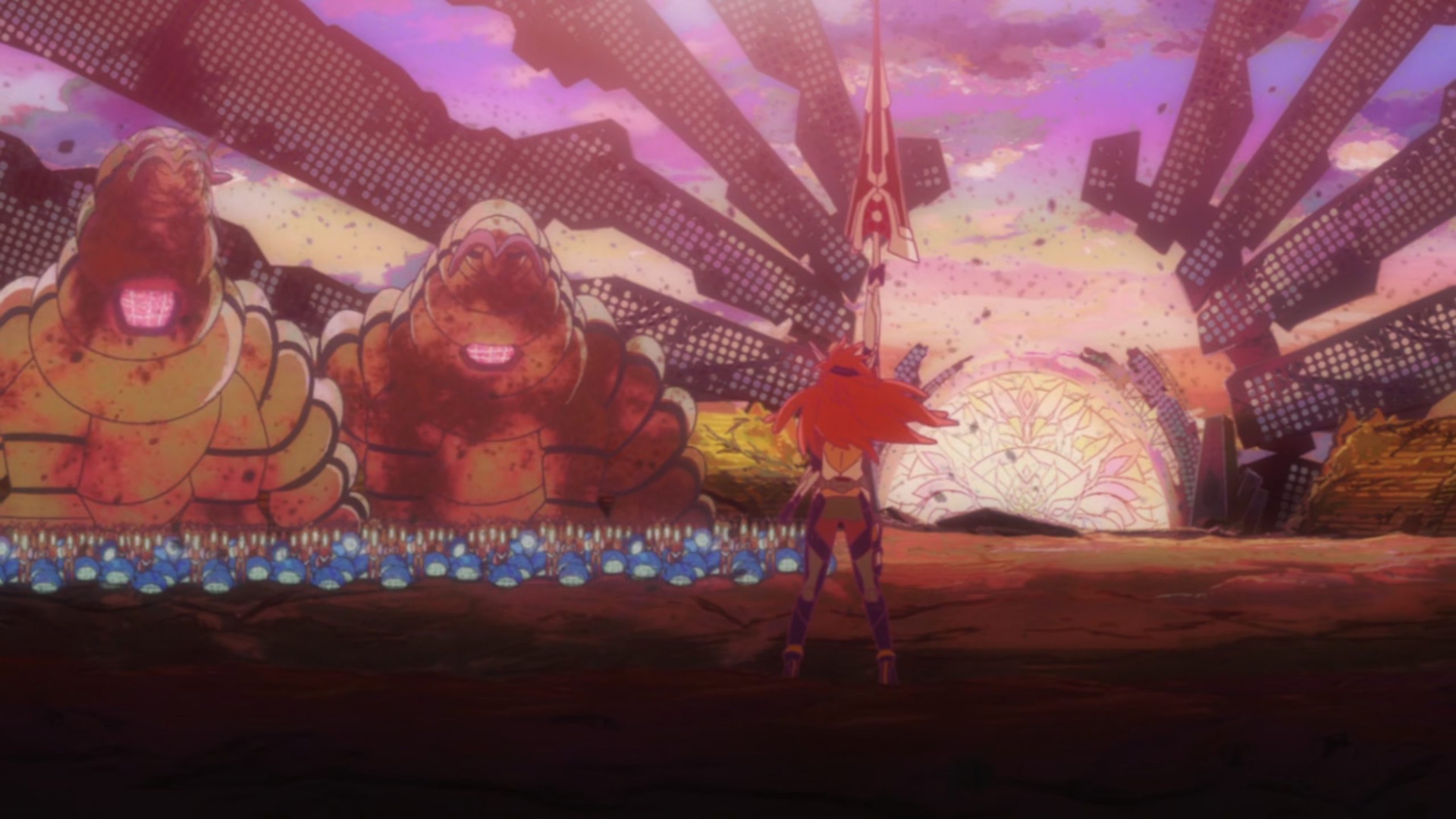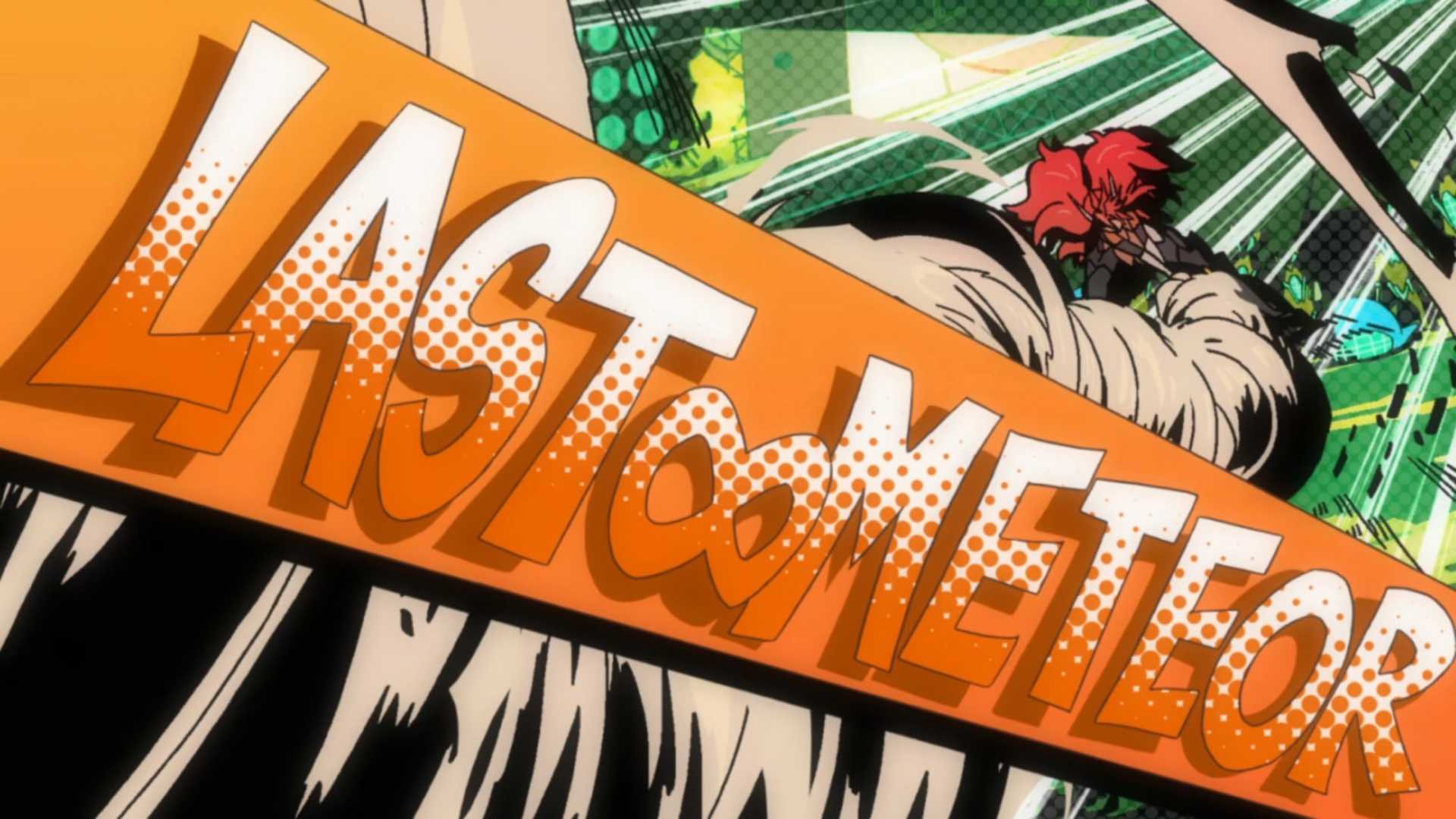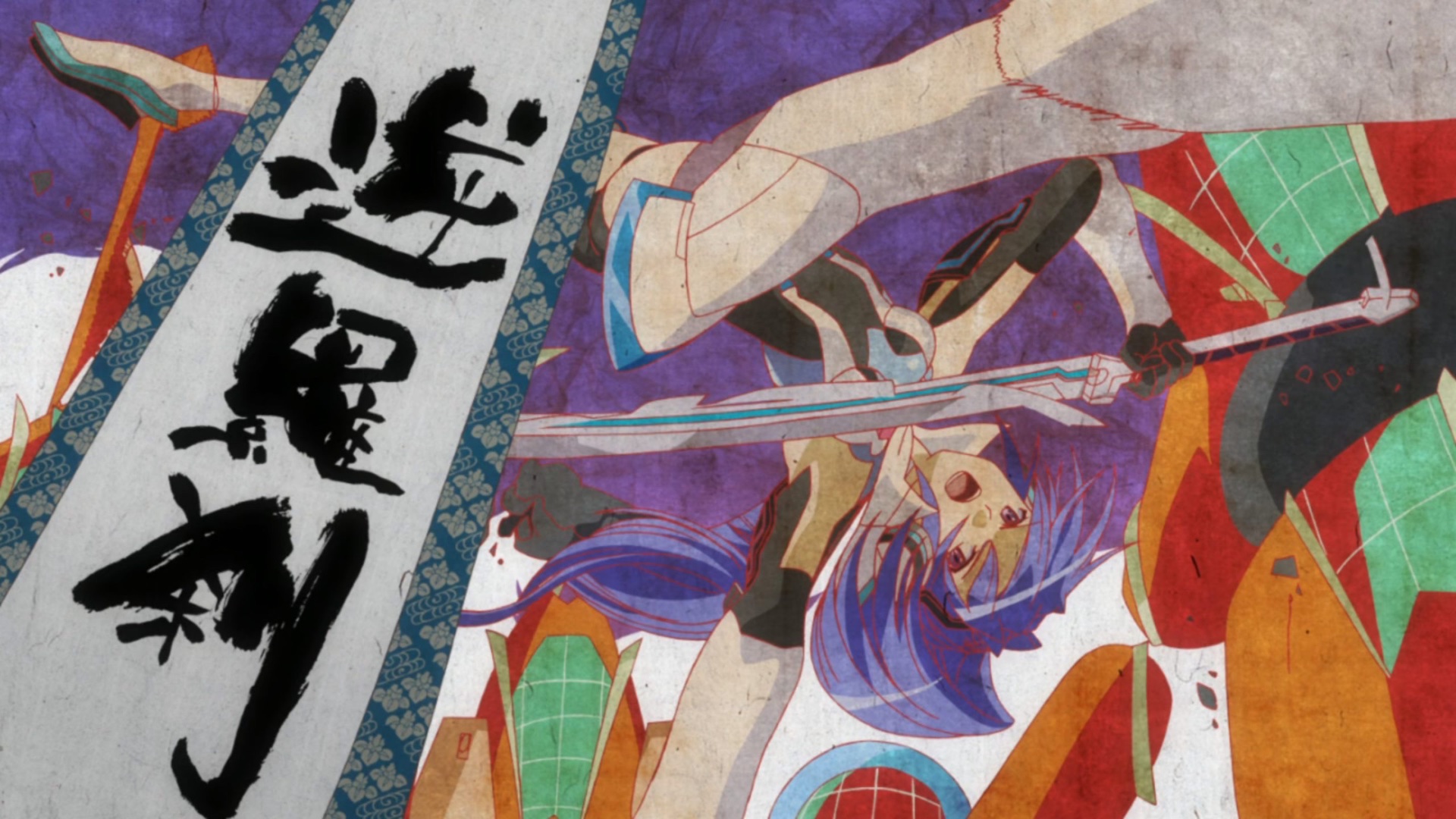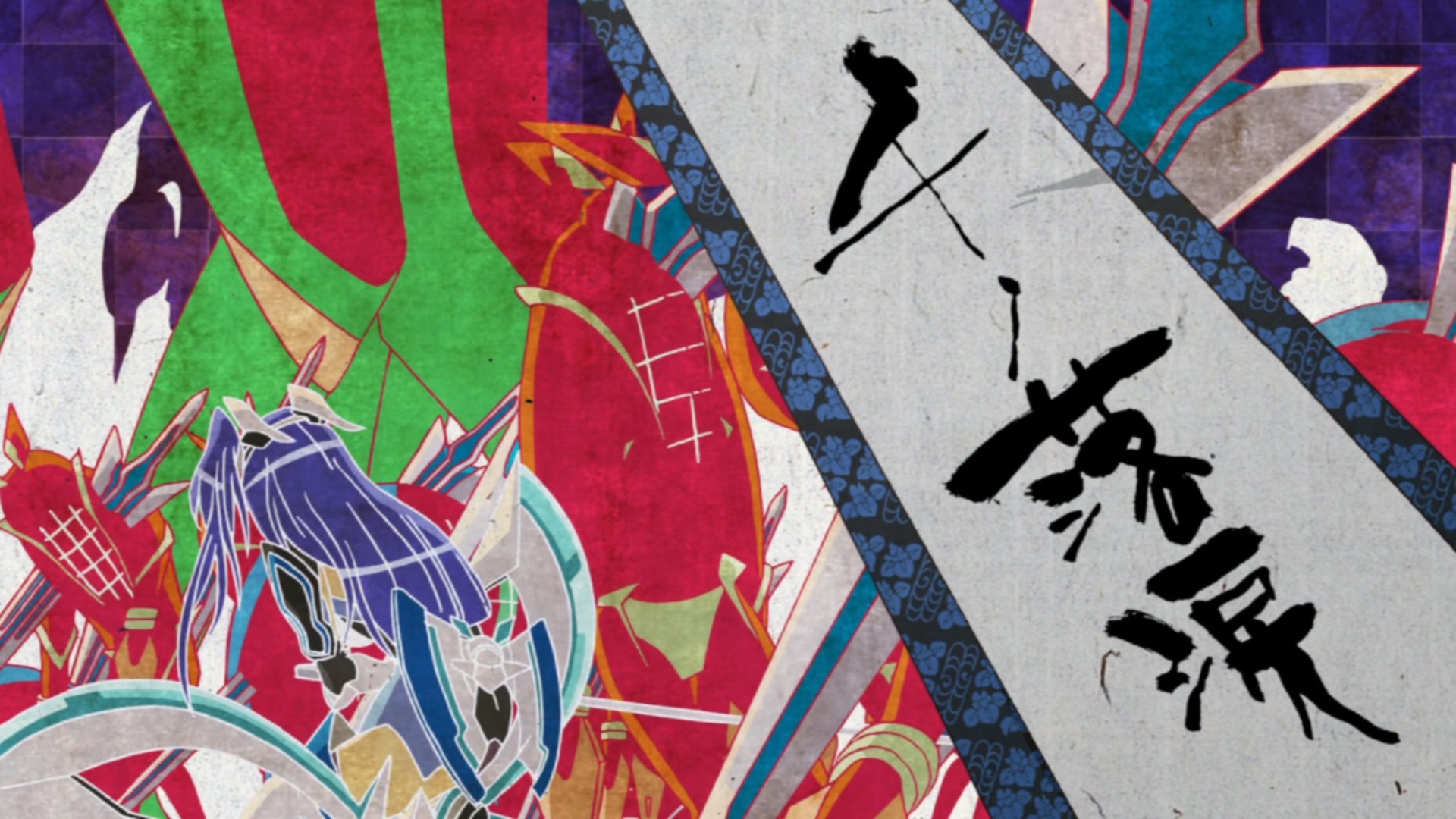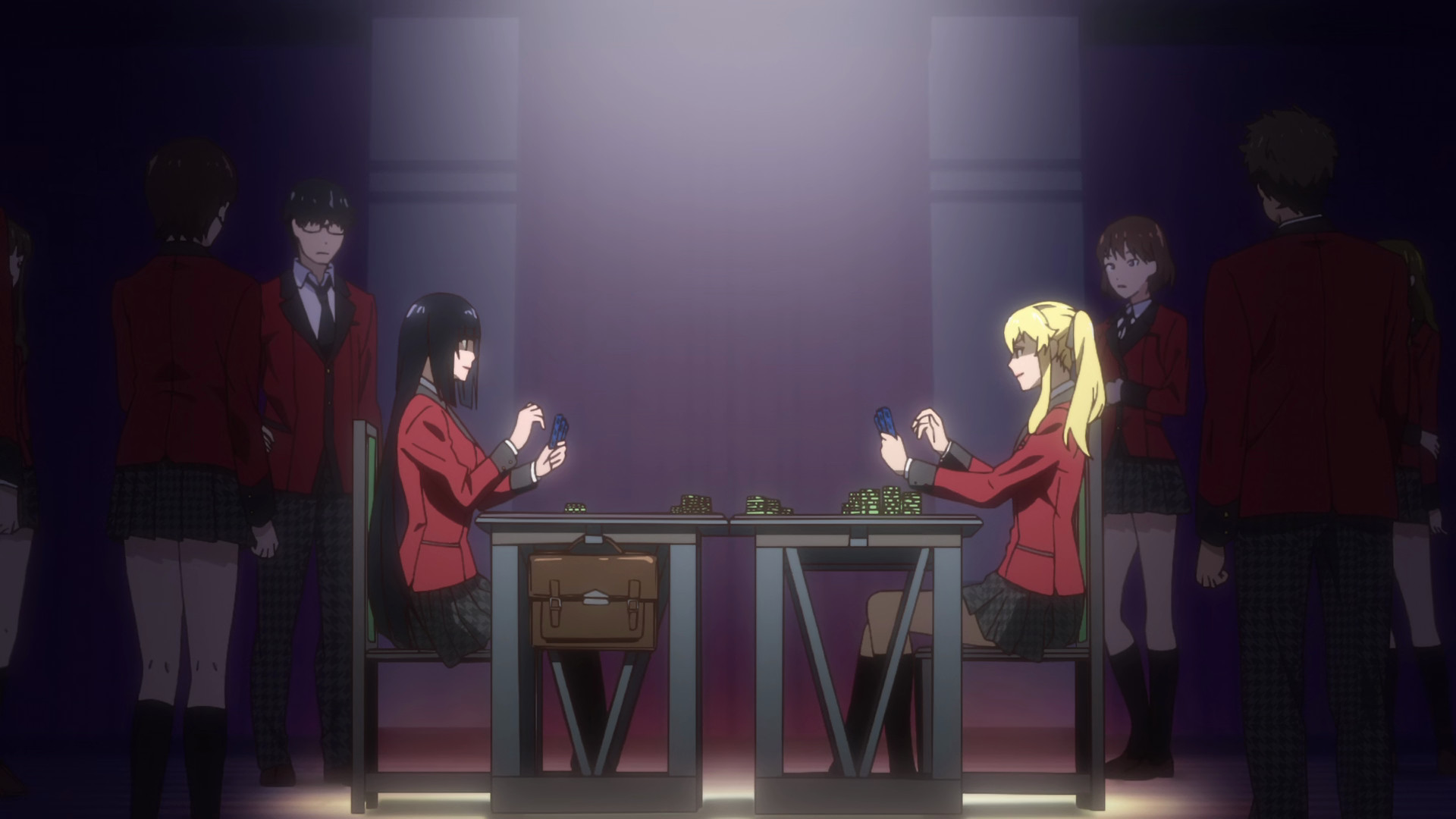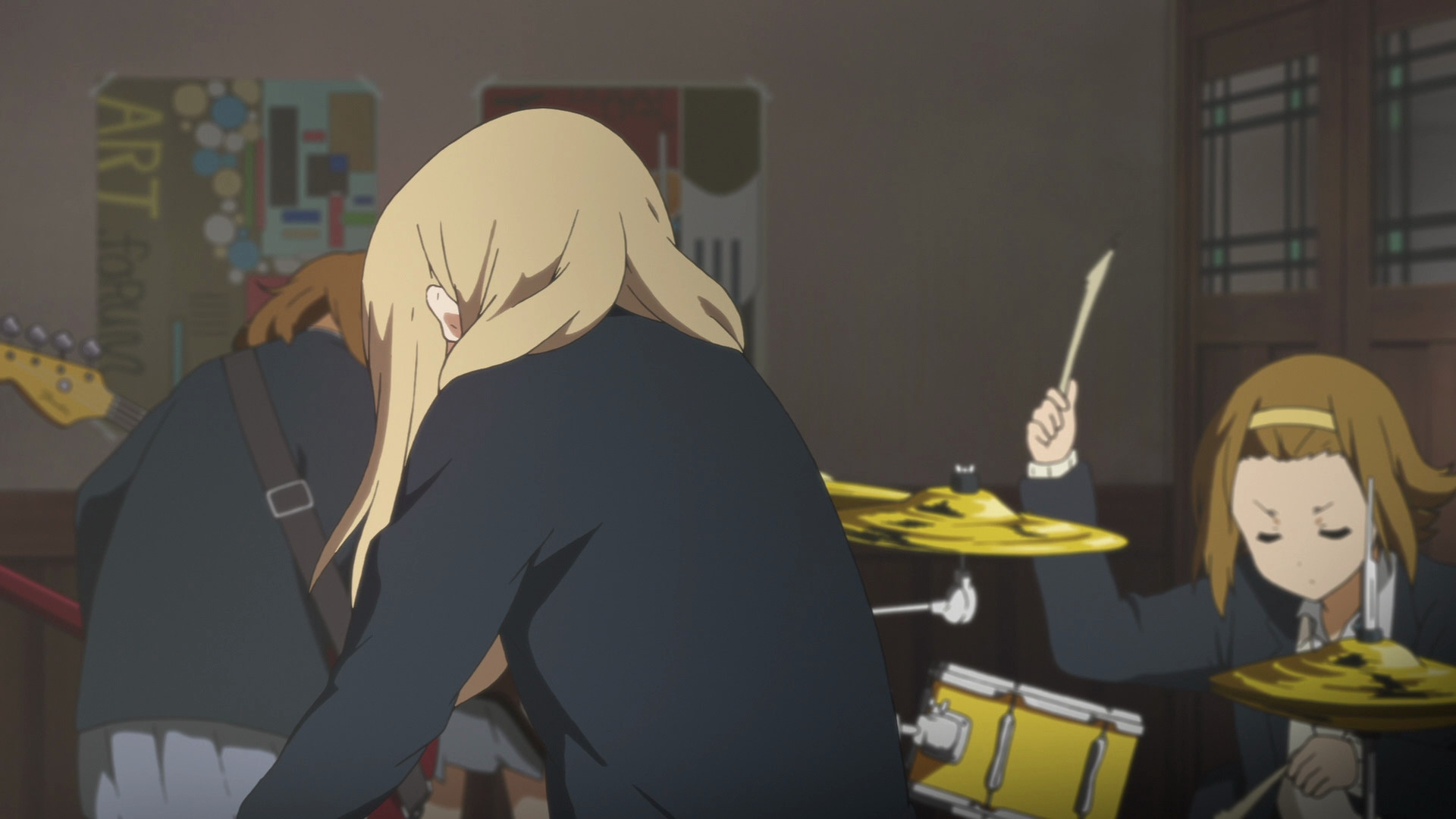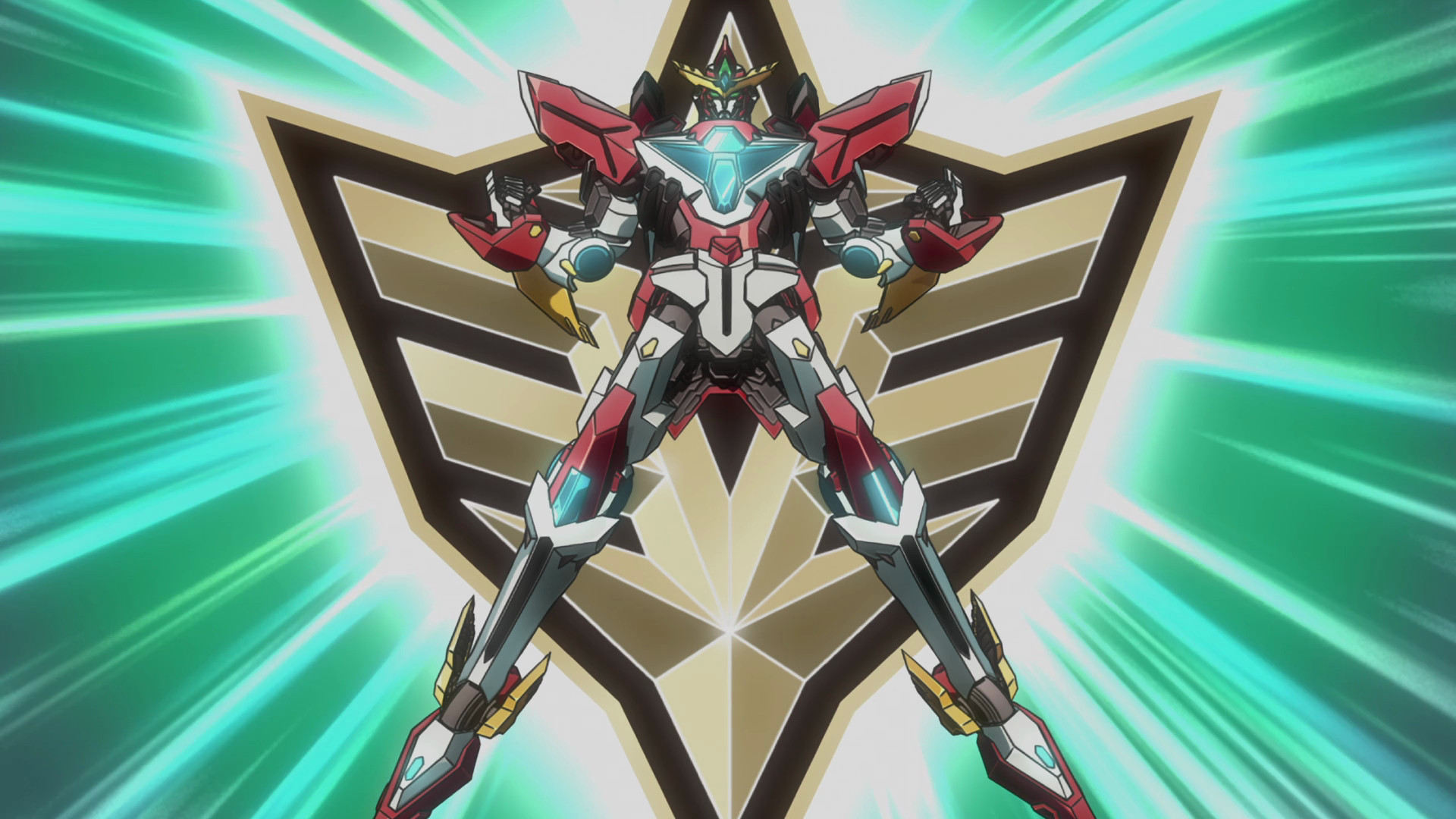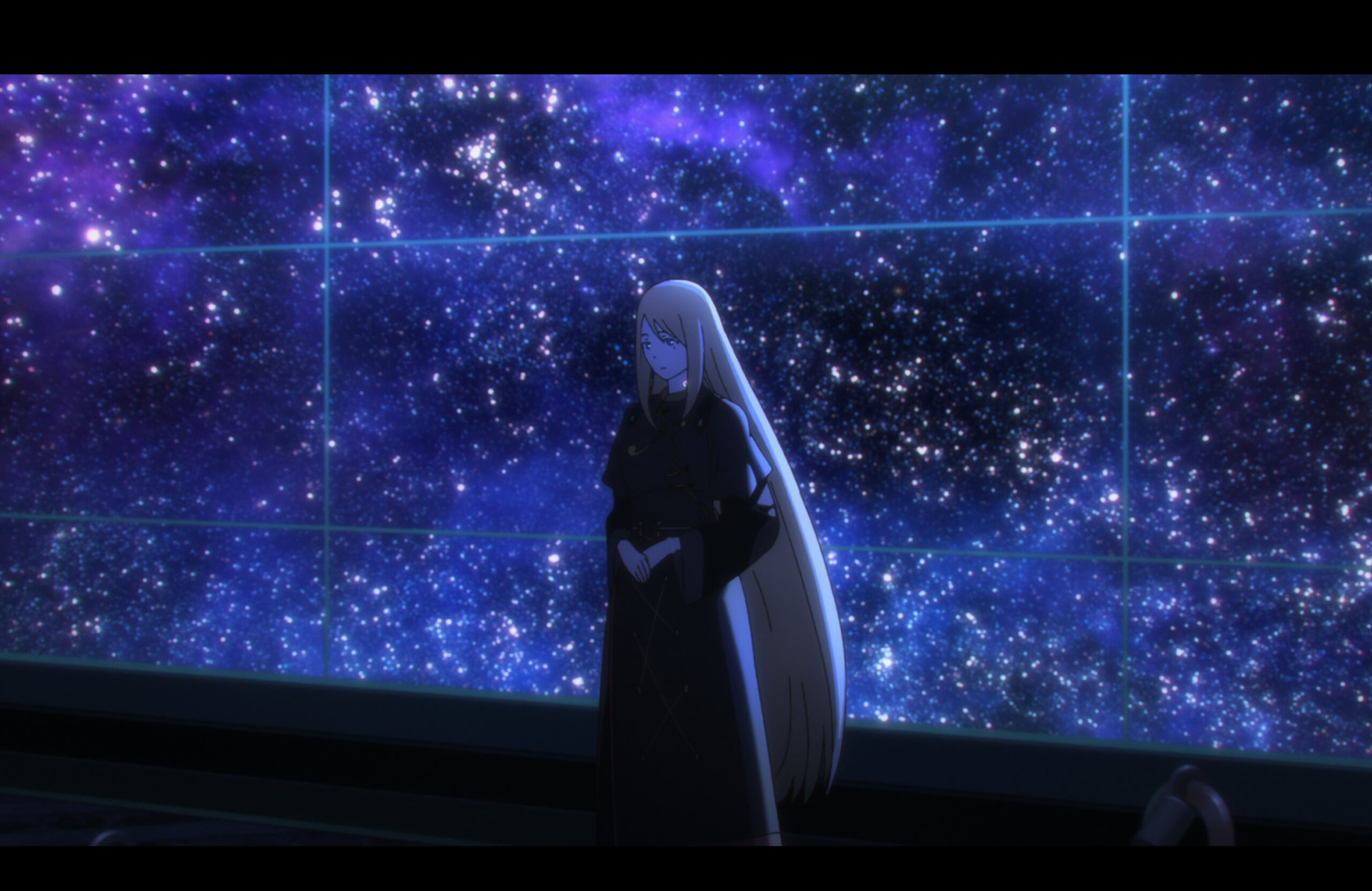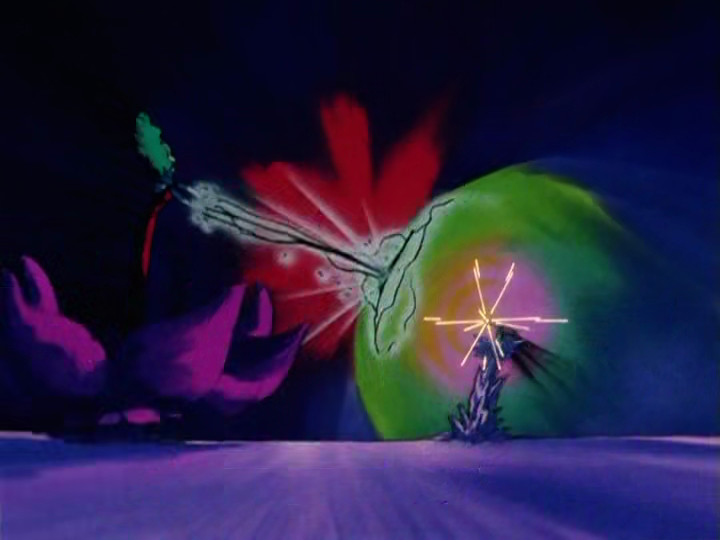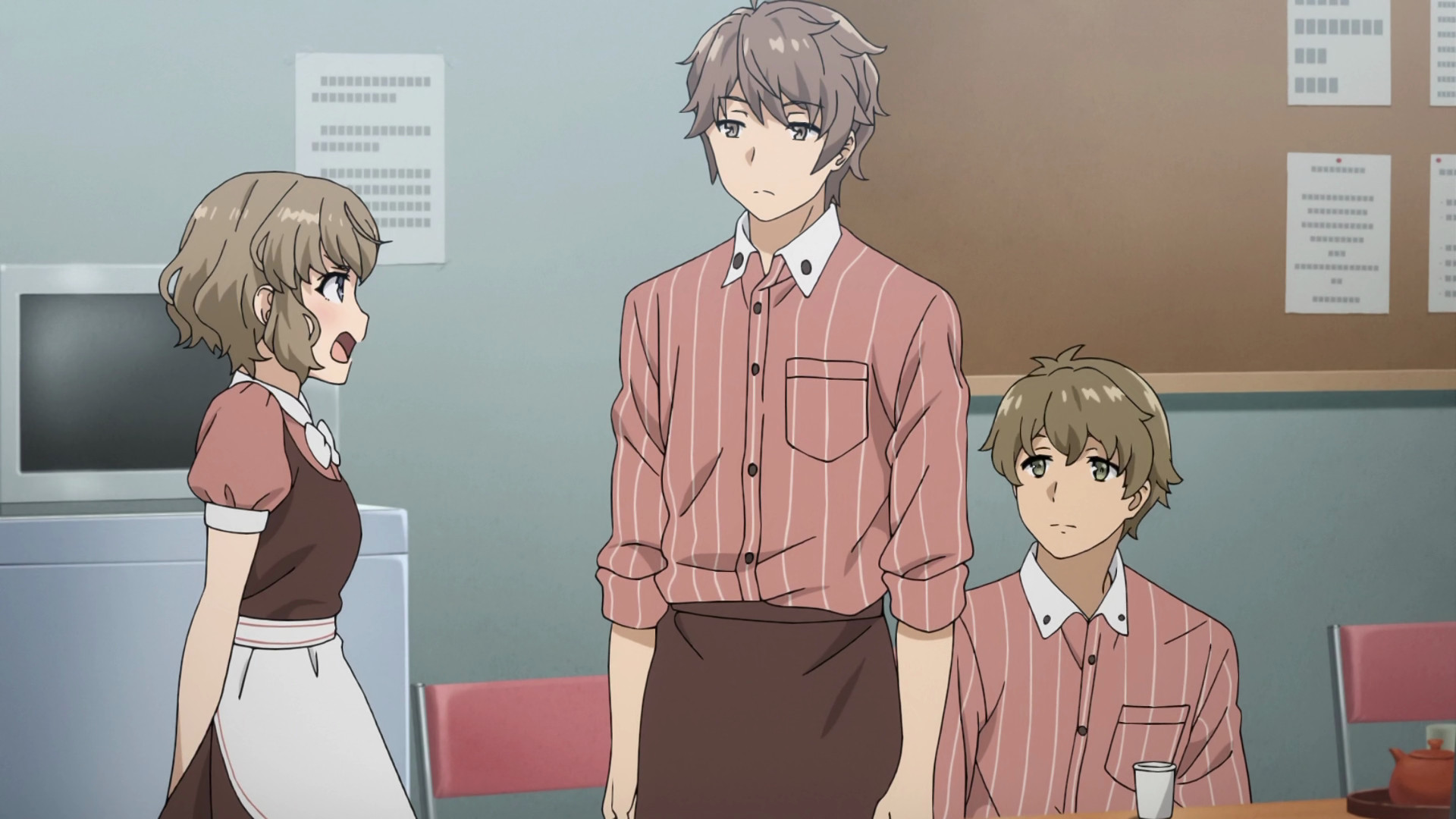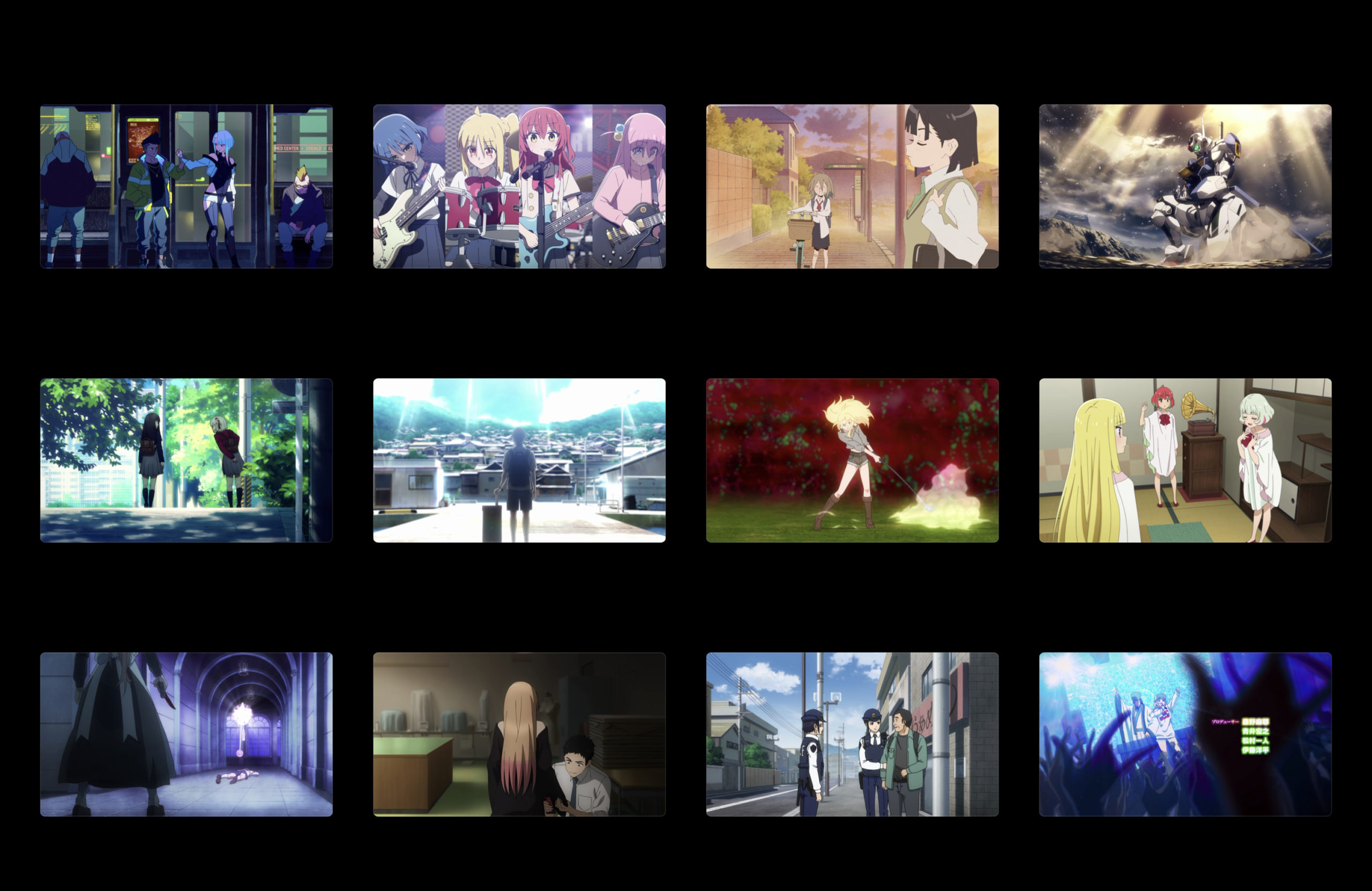Symphogear Episode 02: Noise and Disharmony
Episode Summary:
 We rejoin the action from last episode with Hibiki completing her transformation sequence. She is now clad in the same type of armor that Kanade wore two years ago. Even the instruments at 2nd Division headquarters identify the signature of her armor as Gungnir, much to everyone’s surprise!
We rejoin the action from last episode with Hibiki completing her transformation sequence. She is now clad in the same type of armor that Kanade wore two years ago. Even the instruments at 2nd Division headquarters identify the signature of her armor as Gungnir, much to everyone’s surprise!
A new song springs to Hibiki’s lips as she takes hold of the girl she’s been trying so hard to protect. Hibiki makes a superhuman leap off the top of the building she and the girl were on and lands unharmed on the ground far below. From there, she manages to first evade and then even fight back against the Noise. Where before, the Noise would have turned Hibiki to ash on contact, now Hibiki is even able to punch one with no problem. Hibiki clearly doesn’t have a feel for her new powers, though, as she crashes into buildings left and right unintentionally as she tries to get away. Despite that, she manages to keep herself and the little girl in one piece until Tsubasa can make a flashy entrance.
 Tsubasa easily deals with the Noise, but then she and the staff from 2nd Division arrest Hibiki! They take her back to their headquarters which, it turns out, is located below Hibiki’s school, Lydian Private Music Academy. Although Tsubasa treats the moment as a somber, serious one, Genjuro and the others at headquarters upend the serious mood by throwing Hibiki a surprise welcome party.
Tsubasa easily deals with the Noise, but then she and the staff from 2nd Division arrest Hibiki! They take her back to their headquarters which, it turns out, is located below Hibiki’s school, Lydian Private Music Academy. Although Tsubasa treats the moment as a somber, serious one, Genjuro and the others at headquarters upend the serious mood by throwing Hibiki a surprise welcome party.
Hibiki says an awkward hello to everyone, but is quickly carted off by Ryoko for a medical exam. Hibiki returns home to her dorm that evening worn out only to find a worried Miku waiting for her. That night, as the two fall asleep together, Hibiki tells Miku not to worry to which Miku responds that of course she is going to worry over her friend. Unfortunately, Hibiki is not allowed to tell Miku the truth of what happened.
The next day, we see that Tsubasa is not at all happy with the fact that Hibiki has somehow inherited Kanade’s powers. Back at school, Hibiki wants to go eating with her friends but instead has to report back to 2nd Division to get the results of her medical examination and an explanation of her powers.
 It turns out that Ryoko Sakurai, the self described brains of 2nd Division, crafted special pendants from fragments of ancient relics which can only be used by a small number of Attuned individuals. They use songs to harness the power of these relics and form Symphogear armor. This special armor lets its user fight against the Noise who are impervious to seemingly all other forms of attack.
It turns out that Ryoko Sakurai, the self described brains of 2nd Division, crafted special pendants from fragments of ancient relics which can only be used by a small number of Attuned individuals. They use songs to harness the power of these relics and form Symphogear armor. This special armor lets its user fight against the Noise who are impervious to seemingly all other forms of attack.
We further learn that the reason Hibiki can transform, even without a Relic pendant, is that she still has tiny pieces of Kanade’s Gungnir embedded within her from the Noise attack two years ago. Upon learning this, Tsubasa leaves the room, unable to handle her mixture of outrage and grief. Hibiki soon follows her and joyfully promises to help her fight the Noise, not realizing that she herself is part of the reason Tsubasa is so distraught.
 At that moment a collection of Noise appear nearby and both Tsubasa and Hibiki go to confront them. Tsubasa engages a giant noise that forms when a bunch of smaller ones merge together. Hibiki manages to help out a little before Tsubasa destroys the giant creature.
At that moment a collection of Noise appear nearby and both Tsubasa and Hibiki go to confront them. Tsubasa engages a giant noise that forms when a bunch of smaller ones merge together. Hibiki manages to help out a little before Tsubasa destroys the giant creature.
In the aftermath, Hibiki begs Tsubasa to be allowed to fight alongside her, to which Tsubasa aims her sword at Hibiki and angrily says that yes, the two of them really should fight…
Episode Impressions:
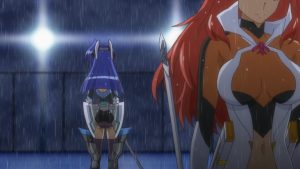 This was a rather subdued, exposition-heavy episode. We got a few minutes of combat at the beginning and end, but for the most part this episode was about two things: Explaining how the Symphogear armor works, and showing us Tsubasa’s mental state following Kanade’s death two years prior.
This was a rather subdued, exposition-heavy episode. We got a few minutes of combat at the beginning and end, but for the most part this episode was about two things: Explaining how the Symphogear armor works, and showing us Tsubasa’s mental state following Kanade’s death two years prior.
I like that the Symphogear armors are, in essence, technological. They harness a not very well understood power, sure, but they do so via technology. That Hibiki and most others barely understand how it works doesn’t really matter. Ryoko does, and that’s what’s important.
It was also good to see that the tragedy at the concert did have a major effect on Tsubasa. She doesn’t appear shy anymore, but she seems to have traded that shyness for a not entirely successful attempt at being an unfeeling warrior.
Specific Scenes I Loved:
 That brief moment as Hibiki holds out her hand to the little girl and cradles her in her arms. There’s a powerful strength there that I really liked.
That brief moment as Hibiki holds out her hand to the little girl and cradles her in her arms. There’s a powerful strength there that I really liked.
Tsubasa’s final, as yet unnamed, finishing attack when she arrived to rescue Hibiki. She took out that large noise by impaling it with a sword the size of a medium sized building!
 Hibiki’s admission that she barely understood any of the information she’d just been given about the Symphogear. Her voice and bemused, closed-eyed smile is just so cute in that moment!
Hibiki’s admission that she barely understood any of the information she’d just been given about the Symphogear. Her voice and bemused, closed-eyed smile is just so cute in that moment!
The way Tsubasa had to leave the room as they started talking about why Hibiki could summon a Symphogear. Tsubasa is clearly not doing ok with her loss.
Songs In This Episode:
Gekisou Gungnir (Gungnir, the Striking Spear) – This is Hibiki’s first song as a Symphogear users. Like most of the songs sung during combat, it is the voiced expression of her current thoughts and emotions.
Her song here is pretty neat. She’s basically saying that her singing is enough to bridge the communication gap between people that words sometimes cannot. And, that she’s going to use this newfound power of song to push forward into the future. Her song is kinda simple and straight forward, like she is. While there’s a line about not crying, this isn’t a song full of the pain / regret / suffering that Tsubasa’s was last episode. It’s a song of hope and bringing that message of hope to the future.
Also… I love the bagpipes it kicks off with!
Zettō Ame no Habakiri (Ame no Habakiri, the Ultimate Blade) – Tsubasa’s song continues to be awesome. I like its power and the way it feels like something spectacular and imposing is about to happen.
Themes In This Episode:
 Tsubasa vs Hibiki: One of the largest themes throughout this episode is Tsubasa’s reaction to Hibiki inheriting Kanade’s Symphogear. Tsubasa expressed the idea to herself that Hibiki is using a power that should still be Kanade’s. We also see something of a repeat of Kanade’s words about everything being ok as long as she and Tsubasa are together. Obviously, they aren’t together anymore… So, obviously things aren’t ok?
Tsubasa vs Hibiki: One of the largest themes throughout this episode is Tsubasa’s reaction to Hibiki inheriting Kanade’s Symphogear. Tsubasa expressed the idea to herself that Hibiki is using a power that should still be Kanade’s. We also see something of a repeat of Kanade’s words about everything being ok as long as she and Tsubasa are together. Obviously, they aren’t together anymore… So, obviously things aren’t ok?
Does Tsubasa see this as Hibiki’s fault? Would she rather Hibiki have died if it meant Kanade could have lived? Hopefully Tsubasa is a better person than that, but it’s possible that kind of negative response is her first, grief-tinted reaction to seeing Hibiki using Gungnir. Or, could it be that Tsubasa doesn’t think Hibiki is up for the hard, life threatening role of being a Symphogear user? Again, we just don’t really know because Tsubasa hasn’t really expressed her feelings at all.
 Hibiki, for her part, isn’t doing a lot to win Tsubasa over. Hibiki seems to think promising to fight the Noise alongside Tsubasa is what Tsubasa wants to hear, but it probably isn’t. Hibiki feels like a very energetic personality who tries to fix things by throwing herself into a situation, but so far Tsubasa doesn’t need help. She needs Hibiki to understand what Kanade’s death meant. Hibiki simply saying “I want to help!” isn’t enough. There’s emotions of sadness and grief radiating off of Tsubasa that Hibiki hasn’t even acknowledged yet. Things will probably stay bad between the two until Hibiki gets a clue.
Hibiki, for her part, isn’t doing a lot to win Tsubasa over. Hibiki seems to think promising to fight the Noise alongside Tsubasa is what Tsubasa wants to hear, but it probably isn’t. Hibiki feels like a very energetic personality who tries to fix things by throwing herself into a situation, but so far Tsubasa doesn’t need help. She needs Hibiki to understand what Kanade’s death meant. Hibiki simply saying “I want to help!” isn’t enough. There’s emotions of sadness and grief radiating off of Tsubasa that Hibiki hasn’t even acknowledged yet. Things will probably stay bad between the two until Hibiki gets a clue.
Tsubasa’s offer for herself and Hibiki to fight isn’t a good sign. I don’t think Tsubasa means to actually harm Hibiki, but she might try to scare her away. Or, Tsubasa might take her anger, grief, and frustration out on Hibiki. I think it’s too early for anyone to actually be injured in such a fight, but it is going to be interesting to see how this plays out.
Special Attacks In This Episode:
Things You Should Pay Attention To:
That the 2nd Division’s headquarters is built below Hibiki’s school and is a mixture of modern and ancient technology is interesting.
Symphogear relics don’t activate for just anyone and it takes more than someone just humming a song. This would mean those who can summon a Symphogear are special in some way.
Hibiki is converting the power of Gungnir directly instead of using a Symphogear pendant like Tsubasa and Kanade used.
Hibiki is not allowed to tell anyone, Miku included, about her new double life as a super heroine.
Both in this episode and in the first one, the Noise appeared somewhat near the school. Is there a reason for that? Because the headquarters is there?
Moment By Moment Notes:
0:09 – Aufwachen is German for waking up. So… an awakening waveform?
0:19 – Confirmation that Hibiki’s Symphogear is the same as Kanade’s
0:23 – The OP. Remember, we’ll dig into the song and imagery near the end of the season to avoid spoilers.
1:55 – Bagpipes?!
2:15 – I love that little moment where Hibiki reaches out her hand and the girl takes it. That hug Hibiki gives her is so protective while also being bad ass!
3:15 – Hibiki’s first punch!
3:29 – Wait… if military grade guns and missiles don’t affect the noise, then isn’t that a waste of a perfectly good motorcycle?!
4:00 – Blue Flash
4:09 – One Thousand Tears
4:31 – I did not expect a sword that big! But, aww, the attack didn’t get a name. 🙁
4:51 – And that, my friends, is a military grade vacuum cleaner! :p
5:28 – Not even a hint of a smile
7:28 – That moment the elevator emerges into the wider shaft is pretty cool!
8:03 – She’s worried how her picture will look with handcuffs. What a goof!
10:35 – Miku is the best. (This comment will appear frequently. I herby promise to always copy and paste it, every single time.)
12:01 – There’s nothing to fear while we’re together
12:08 – That gear is Kanade’s!
12:16 – I like the random girl playing the horn. It’d be so annoying, but kinda hilarious!
12:25 – Flower is a shop that serves okonomiyaki… which is kinda like pancakes but tends to have vegetables or other stuff layered on top. So… “pancake place” isn’t an exact translation here.
12:36 – Your life is like an anime character’s.
14:30 – So she didn’t just sing at random, the power of the Symphogear relic guided her singing or made her sing?
16:11 – So, there are still some tiny pieces of Kanade’s Gungnir in Hibiki. (Also… isn’t this close to the origin story of Iron Man?! :p)
18:33 – Yeah, Tsubasa doesn’t seem thrilled at that…
19:36 – I think it’s good that the show acknowledges how strange it is to put yourself in the way of unkillable monsters from another dimension…
19:54 – The echo from the emergency speakers is really good.
20:24 – Tsubasa’s first transformation sequence
21:21 – Blue Flash
21:58 – Wait… should fight together or fight against each other?!
22:34 – Huh. This ending animation is actually pretty disturbing! (We’ll talk about it later.)
AniManga Picture Challenge Week 1 - Summer Fun
The return of the #AniMangaPictureChallenge’s #AniMangaFoundIt
was a success. From exploring the outdoors, to visiting the beach or pool, to the classic yuri aquarium date, #anime and #manga offer great ways to beat the summer heat!
Thanks to all who participated and to all who enjoy this content each week. New topic tomorrow morning!
Anime Animals アニメの動物 - Teasing Master Takagi-san
My Little Ponfarr - Pseudo Harem
Retro Goth Bunny - Bloom Into You
Mole - Barakamon
CT - Rama 1/2
Anicast - The Melancholy of Haruhi Suzumiya
Ragashingo - Macross Frontier
Symphogear Episode 01: Beat of Awakening
Welcome to the Senki Zessho Symphogear Episode Guide. Symphogear is one of my favorite anime of all time and I’m thrilled to share it with you! First off, a quick programming note. For this season, we’ll be using the Deetruck fan subs. I recommend these because of the way they separate the many songs from the spoken dialogue during episodes.
Episode Summary:
 This first episode opens abruptly to the sound of heavy rainfall. We see a girl standing at a bus stop soaked by the rain. We soon see that she’s holding a bouquet of flowers… lilies, most likely… which is soon confirmed as she gets on a bus and travels to a traditional Japanese gravesite. Lilies, if you don’t know are associated with death and remembrance. Oddly, there is destruction all around her in every scene from the bus stop to the gravesite itself. Something bad has happened. Some sort of disaster! Along the way, the girl thinks of an old proverb about a cuckoo and the way it was thought to cough up blood as it sang. The girl narrates that her very best friend, the one whose grave she is apparently visiting, did much the same thing. That she sang on a battlefield even as blood spilled from her mouth!
This first episode opens abruptly to the sound of heavy rainfall. We see a girl standing at a bus stop soaked by the rain. We soon see that she’s holding a bouquet of flowers… lilies, most likely… which is soon confirmed as she gets on a bus and travels to a traditional Japanese gravesite. Lilies, if you don’t know are associated with death and remembrance. Oddly, there is destruction all around her in every scene from the bus stop to the gravesite itself. Something bad has happened. Some sort of disaster! Along the way, the girl thinks of an old proverb about a cuckoo and the way it was thought to cough up blood as it sang. The girl narrates that her very best friend, the one whose grave she is apparently visiting, did much the same thing. That she sang on a battlefield even as blood spilled from her mouth!
We cut back to two years prior. The girl that died, whose name we now know is Hibiki, is standing in line for a concert of some kind and her friend, who we now know as Miku, is apologizing for being unable to join her because her family is having to take a trip to visit an ailing aunt.
 We cut again, this time to the two singers of Zwei Wing who are about to give their concert. Blue-haired Tsubasa is sitting against a crate nervous and shy with her hand’s folded in worry. She is quickly approached by her partner, Kanade, who is much more relaxed and eager to go on stage. After a brief appearance by their manager, Genjuro, Kanade shares some words with Tsubasa. That she needs to be more flexible, that their audience won’t have much fun if they themselves aren’t having a good time. Pulled free of her shell, Tsubasa, too, is looking forward to performing in the concert. She and Kanade move forward hand in hand.
We cut again, this time to the two singers of Zwei Wing who are about to give their concert. Blue-haired Tsubasa is sitting against a crate nervous and shy with her hand’s folded in worry. She is quickly approached by her partner, Kanade, who is much more relaxed and eager to go on stage. After a brief appearance by their manager, Genjuro, Kanade shares some words with Tsubasa. That she needs to be more flexible, that their audience won’t have much fun if they themselves aren’t having a good time. Pulled free of her shell, Tsubasa, too, is looking forward to performing in the concert. She and Kanade move forward hand in hand.
Meanwhile, Genjuro and spunky, upbeat scientist Ryoko Sakurai are setting up some sort of experiment with a strangely shaped object labeled Nehushtan. There are strange projectors pointed at the object. When Genjuro said that the concert will decide the future of mankind, he might just have meant it!
 And now we hit the concert. The light dim, the impressive stadium-spanning stage is lit, and both Kanade and Tsubasa come falling from the heavens to an enthused landing as the crowd goes crazy. The two stand waving to their audience and start in on the impressively paced “Gyakkou no Flugel” (Backlit Wings). They dance and sing in perfect time to the melody until, partway through their song, the lights go out and the music swells and the roof of the stadium splits open into shards to showcase the sunset sky beyond! Our blond-haired girl, Hibiki, is having the time of her life at what is apparently her first concert.
And now we hit the concert. The light dim, the impressive stadium-spanning stage is lit, and both Kanade and Tsubasa come falling from the heavens to an enthused landing as the crowd goes crazy. The two stand waving to their audience and start in on the impressively paced “Gyakkou no Flugel” (Backlit Wings). They dance and sing in perfect time to the melody until, partway through their song, the lights go out and the music swells and the roof of the stadium splits open into shards to showcase the sunset sky beyond! Our blond-haired girl, Hibiki, is having the time of her life at what is apparently her first concert.
Back at the experiment, it appears that Zwei Wing’s song is charging or empowering the Nehushtan object and that everything is going well. The song ends and another begins, but this time something has gone wrong. The object being empowered grows unstable and an explosion rips apart the middle of the stadium. It appears that the experiment area collapses due to the explosion and that only Genjuro and perhaps a few others survived. Then, from above, come strange flying creatures that look like they don’t quite belong in our world. Both Kanade and the audience recognize these creatures as “Noise” and the concert-goers immediately panic and begin to flee. As they do so the Noise descend and start attacking the audience members. Each person touched is quickly and painfully turned to ash!
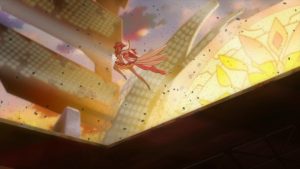 Unwilling to let the attack continue, Kanade leaps off the stage and sings a short, echoing chant. A pendant around her neck glows and suddenly she transforms into a form-fitting orange, white, and black suit adorned with armored pieces that form around her. In her hand is a giant spear. She begins singing a new song and, at the same time, beings cutting into the Noise left and right. She takes out individual Noise with powerful swipes of her spear and takes out dozens at a time with powerful ranged attacks. Following behind her is Tsubasa who has also transformed into a blue set of armor and is cutting apart the Noise with a nodachi.
Unwilling to let the attack continue, Kanade leaps off the stage and sings a short, echoing chant. A pendant around her neck glows and suddenly she transforms into a form-fitting orange, white, and black suit adorned with armored pieces that form around her. In her hand is a giant spear. She begins singing a new song and, at the same time, beings cutting into the Noise left and right. She takes out individual Noise with powerful swipes of her spear and takes out dozens at a time with powerful ranged attacks. Following behind her is Tsubasa who has also transformed into a blue set of armor and is cutting apart the Noise with a nodachi.
Back in the now empty bleachers, Hibiki has apparently become too shocked at the sight before her to flee. Something happens to Kanade and her power appears to dim. She even makes a comment to that effect, that she can’t go any farther. Above her, the rows of seating smash and crumble and send Hibiki tumbling painfully down to the ground floor of the stadium. The nearby Noise being rushing towards her only to be intercepted by Kanade who is then forced to block a spurt of vile liquid ejected at her by one of the building-sized Noise in front of her. Another Noise joins in and Kanade’s armor cracks and parts of it shatter. A few pieces are blown backwards and strike Hibiki directly in the chest! She falls to the ground in a pool of her own blood.
 In a dramatic and chilling moment, Kanade rushes to the blond-haired girl’s side and urges her to keep on living before she then stands and walks calmly towards the large group of Noise arrayed in front of her. With a tear streaming down her face, Kanade lifts her crumbling spear high and sings a soft, chilling song even as Tsubasa yells in desperation for her not to. Back against the wall, our fading, glassy-eyed, Hibiki listens to the beautiful melody. A flow of blood escapes from Kanade’s lips as she finishes her song and then all the Noise present in the stadium are blown away in an instant. And, just like that, Kanade topples sideways to the ground.
In a dramatic and chilling moment, Kanade rushes to the blond-haired girl’s side and urges her to keep on living before she then stands and walks calmly towards the large group of Noise arrayed in front of her. With a tear streaming down her face, Kanade lifts her crumbling spear high and sings a soft, chilling song even as Tsubasa yells in desperation for her not to. Back against the wall, our fading, glassy-eyed, Hibiki listens to the beautiful melody. A flow of blood escapes from Kanade’s lips as she finishes her song and then all the Noise present in the stadium are blown away in an instant. And, just like that, Kanade topples sideways to the ground.
Our blond-haired girl is in bad shape. She’s barely able to keep her eyes open now, but she does so just long enough to see Tsubasa embracing her partner. Shockingly, Kanade’s entire body disintegrates and is blown away by the wind as Tsubasa cries painful tears above her. When Hibiki next awakens she is in the middle of an operating room, surprised that she is still alive.
 We jump forwards almost two years and find our blond-haired girl, whose full name is named Hibiki Tachibana, attending school with Miku. The two return to their rather spacious dorm room where we find that Hibiki has always had a thing for going far out of her way to help people. And that she choose to attend Lydian Private Music Academy along with Miku because it is the school Tsubasa attends. Two years prior, Hibiki didn’t even know who Zwei Wing were, but now she is a huge fan of Tsubasa’s who has continued her music career solo after Kanade’s death. We find that Hibiki isn’t actually sure of what she saw that day at the concert. She only knows that many people died and that she barely survived with a large scar on her chest.
We jump forwards almost two years and find our blond-haired girl, whose full name is named Hibiki Tachibana, attending school with Miku. The two return to their rather spacious dorm room where we find that Hibiki has always had a thing for going far out of her way to help people. And that she choose to attend Lydian Private Music Academy along with Miku because it is the school Tsubasa attends. Two years prior, Hibiki didn’t even know who Zwei Wing were, but now she is a huge fan of Tsubasa’s who has continued her music career solo after Kanade’s death. We find that Hibiki isn’t actually sure of what she saw that day at the concert. She only knows that many people died and that she barely survived with a large scar on her chest.
Elsewhere, members of the Japanese Self Defense Forces are engaging a group of Noise, but find that their bullets and missiles have no effect on the otherworldly creatures. But then, a helicopter flies low overhead and drops a serious, emotionless Tsubasa to the ground right in front of the Noise. Defying Genjuro’s orders, Tsubasa engages the enemies before her, and in an impressive display of power, she strikes them down with a quick combination of powerful close and long ranged attacks.
 The next day, Hibiki finally gets her chance to meet Tsubasa, but their encounter doesn’t go like she hoped. Tsubasa, still emotionless, merely points out that Hibiki has some rice on her face before moving on. Later, Hibiki races to a music shop in the nearby city eager to pick up Tsubasa’s latest CD when disaster strikes. It seems the Noise have been rampaging nearby and have already killed several civilians. Hibiki hears a scream and runs to assist a little girl cornered by them. The two flee across a stream and up a highway as Hibiki remembers a little bit more of what happened to her at the concert. Hibiki and the girl manage to reach a high rooftop in what looks to be an industrial complex. For a moment it looks like they are safe, but then they see that the Noise have surrounded them.
The next day, Hibiki finally gets her chance to meet Tsubasa, but their encounter doesn’t go like she hoped. Tsubasa, still emotionless, merely points out that Hibiki has some rice on her face before moving on. Later, Hibiki races to a music shop in the nearby city eager to pick up Tsubasa’s latest CD when disaster strikes. It seems the Noise have been rampaging nearby and have already killed several civilians. Hibiki hears a scream and runs to assist a little girl cornered by them. The two flee across a stream and up a highway as Hibiki remembers a little bit more of what happened to her at the concert. Hibiki and the girl manage to reach a high rooftop in what looks to be an industrial complex. For a moment it looks like they are safe, but then they see that the Noise have surrounded them.
With the Noise nearly upon them, a familiar chant springs to Hibiki’s lips. Her voice echoes as she sings it and then she falls to her hands and knees as the same orange, white, and black armor that Kanade wore encases her! Hibiki stands up with a frightening look of power in her eyes as the episode ends.
Episode Impressions:
 I thought this was a pretty strong opening episode. If it’s job was to get me hooked for a second episode, then I’d say it did a great job. The concert scene and battle scene was almost custom made for me seeing as I come from a Macross background where of course singing and combat go hand in hand. And Hibiki’s transformation was a great mini cliffhanger that promised more cool things to come.
I thought this was a pretty strong opening episode. If it’s job was to get me hooked for a second episode, then I’d say it did a great job. The concert scene and battle scene was almost custom made for me seeing as I come from a Macross background where of course singing and combat go hand in hand. And Hibiki’s transformation was a great mini cliffhanger that promised more cool things to come.
I also thought this episode did a good job establishing characters. Hibiki as the goof with a heart of gold, and Tsubasa as first a shy girl and then as a no-nonsense warrior. And I liked the way they did both of these. So much of Tsubasa’s character was established just by her sitting nervously in her cloak. And Hibiki, her little chant about buying the CD as she ran was almost all we needed from her.
 Technically the episode had a couple of blemishes. Both the bus Miku gets on and the oil tanker coming into port in the beginning just looked a bit off. A couple of the 3d camera moves in the concert scene were a bit unnatural, as well. But beyond that, the art, animation, sound, and music were all somewhere between good and excellent. If the show can keep itself at this level all the way through then I think it will be very enjoyable.
Technically the episode had a couple of blemishes. Both the bus Miku gets on and the oil tanker coming into port in the beginning just looked a bit off. A couple of the 3d camera moves in the concert scene were a bit unnatural, as well. But beyond that, the art, animation, sound, and music were all somewhere between good and excellent. If the show can keep itself at this level all the way through then I think it will be very enjoyable.
Specific Scenes I Loved:
 Kanade and Tsubasa’s introduction. All it took was a sit and a hug and a few words to set up Tsubasa’s reserved character and Kanade’s far more outgoing personality. Sure, Tsubasa’s declaration that they could do anything as long as they were together instantly made me fear things would end badly, but it was pretty cool seeing a relatively small amount of animation do so much work in establishing two characters.
Kanade and Tsubasa’s introduction. All it took was a sit and a hug and a few words to set up Tsubasa’s reserved character and Kanade’s far more outgoing personality. Sure, Tsubasa’s declaration that they could do anything as long as they were together instantly made me fear things would end badly, but it was pretty cool seeing a relatively small amount of animation do so much work in establishing two characters.
The concert, of course! Symphogear was produced by a studio called Satelight who has plenty of experience combining anime and music. Their work in this episode was near the top of their game with only the concert scenes in one of their previous series, specifically the Macross Frontier movies, potentially topping this one. Here, the hand drawn animation was downright excellent and the computer animated stadium in the background and camera movements that put the two together were pretty good, as well. The opening couple of shots of Kanade and Tsubasa dancing are a little stiff, a little unnatural in the way the camera moves in exactly one direction and doesn’t vary the speed of its movement much. These first few shots feel just a bit too mechanical, and the zooms are a bit too abrupt to start and stop. But the animation of Kanade and Tsubasa keeps up to even those somewhat jerky movements perfectly! That shot a little later on where the camera spins out into the audience is pretty darn cool. As a first try at a dynamic, engaging concert, this was pretty good, if maybe just a tad too ambitious for what they were able to pull off. But you can see the high bar they are aiming for. And they got pretty close to achieving it!
 That brief moment during the concert where the roof lights up with Kanade and Tsubasa’s colors then opens to reveal the sunset is surprisingly powerful. Great combination of animation and music.
That brief moment during the concert where the roof lights up with Kanade and Tsubasa’s colors then opens to reveal the sunset is surprisingly powerful. Great combination of animation and music.
The battle against the Noise at the concert. So many cool things happen so quickly. Kanade taking out dozens of Noise with her special attacks. Her and Tsubasa’s cool run towards the camera where they destroy the Noise standing in their way. Kanade’s Superb Song and the way it saves the day at the cost of her life.
Tsubasa’s present day fight against the Noise. She disobeys orders to engage, but there’s no sign that she finds much joy in her victory. She wasn’t in a revenge rage, either. It was more like she was fighting out of a sense of duty but without a sense of satisfaction. As if the duty was her only reason for fighting now. Also, note her “One Thousand Tears” attack. It looks very similar to Kanade’s “Stardust Foton”. I think it is basically the same attack performed by Tsubasa in tribute or remembrance of Kanade with a new name that expresses Tsubasa’s sorrowful feelings.
Hibiki’s flight from the Noise. She is doing everything she can to keep herself and the little girl alive and in doing so she remembers that similar order that Kanade gave her two years before.
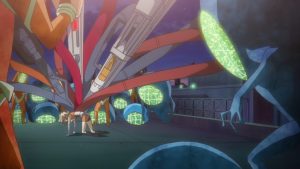 Hibiki’s first transformation. With Kanade, the transformation looked intentional and almost mechanical the way her armored pieces attached themselves to her. With Hibiki, all that techno-crap emerging from her body looked uncontrolled and painful! Is that the way she will transform every time, or was it a one off because it was her first transformation? Or do these heroines always transform like that and we just didn’t see it from Kanade or Tsubasa’s point of view?
Hibiki’s first transformation. With Kanade, the transformation looked intentional and almost mechanical the way her armored pieces attached themselves to her. With Hibiki, all that techno-crap emerging from her body looked uncontrolled and painful! Is that the way she will transform every time, or was it a one off because it was her first transformation? Or do these heroines always transform like that and we just didn’t see it from Kanade or Tsubasa’s point of view?
Songs In This Episode:
Gyakkou no Flugel (Backlit Wings) – This song was a fantastic choice to open the series and a great way to open the first concert. Its concert version is exciting, and it was great to see that the audience knew the song and was able to shout out some of the key lyrics. The song itself is about friendship, possibly even romance, and the way music can inspire people to support each other as they reach towards lofty goals together.
Orbital Beat – We only hear the very beginnings of this song as things start to go wrong at 2nd Division’s headquarters. Unfortunately, it is cut off by the explosion before we get to hear any of its lyrics. It’s actually a pretty cool song and we’ll get to hear it someday. For now, it is important to know that practically all of the voiced songs you hear in Symphogear have full length versions. Even Gyakkou no Flugel above was just a shortened two minute version of what is a five minute song.
Kimi to Iu Oto Kanade Tsukiru Made (Play Out the Sound That Is You to the Very End) – This is a personal song of Kanade’s that is all about her friendship with Tsubasa. It starts with reflections on her past days before the horror with the Noise began. Then it moves to talk about how the two of them can go anywhere they wish, even above the sadness they both face. The most chilling part is the idea put forth that maybe she and Tsubasa met so that they could survive these tragic days together. This shortened versions then ends with Kanade promising to sing along side Tsubasa until her very end… which of course comes a short time later.
Like all the Symphogear songs sung during combat, Kanade’s final song is an amplified reflection of the thoughts and feelings flowing from her heart. The two things she is thinking about are her gentle past that now seems like a miracle to her in its normality, and her relationship and partnership with Tsubasa. For a song that Kanade charges into battle with, it’s almost like she somehow already knows that things aren’t going to go well.
Zessho (Superb Song) – The lyrics here seem entirely meaningless. They read:
Gatrandis babel ziggurat edenal
Emustolronzen Finé el balal zizzl
Gatrandis babel ziggurat edenal
Emustolronzen Finé el zizzl
At this point in the series, this song’s power and weight comes from Kanade’s tragic end. We’ll hear this song again at some point and learn some more about it. This is a key song in Symphogear, and you’ll hear bits and pieces of its melody spread all throughout the series. There will be more to say about the Superb Song in this season and beyond, but I’ll leave it at this for now.
Shiritsu Lydian Ongakuin Kōka (The Lydian Private Music Academy Anthem) – This is a fairly simple, straight forward song about greeting the sun and believing in one’s self even if you find tears at some point in your future. It’s kinda a classic Japanese school song. You can hear similar songs all across anime given so many shows feature students at school. Again, we only hear part of this song, the first half or so.
Zettō Ame no Habakiri (Ame no Habakiri, the Ultimate Blade) – This is Tsubasa’s main character song this season. We get a pretty abbreviated version of it here, one that even skips some of the lyrics to fit in the bits important to the scene. I found three fairly different translations of the lyrics, but they all point to Tsubasa singing her grief at Kanade’s death along side the possibly suicidal resolve that the loss of her closest ally has given Tsubasa as she continues her fight. It all ties together by saying that the bond she had with Kanade is what now powers or drives her blade.
This song will quickly become synonymous with Tsubasa, and we’ll hear it again in multiple different versions thought the season.
Synchrogazer – Although it is heard at the end of the first episode, this is actually the opening song for this season. One of the things I’ll do is save discussion of the opening and ending songs for the end of each season so we can talk about both the songs and the imagery they are paired with, without going into spoilers.
Themes In This Episode:
 Self Sacrifice: Right out of the gate we have Miku talking about how Hibiki dies on the battlefield with blood spilling out of her mouth. I think the implication is that Hibiki will sacrifice herself singing her Superb Song much the same way Kanade did in this episode. So, I think our first real theme in Symphogear is the willingness to sacrifice one’s self for others. If anything, Kanade sacrificed herself to save just one person. It seems she could have withdrawn if Hibiki hadn’t fallen near her. She definitely knew she was at her limit, but she stayed and died for Hibiki’s sake.
Self Sacrifice: Right out of the gate we have Miku talking about how Hibiki dies on the battlefield with blood spilling out of her mouth. I think the implication is that Hibiki will sacrifice herself singing her Superb Song much the same way Kanade did in this episode. So, I think our first real theme in Symphogear is the willingness to sacrifice one’s self for others. If anything, Kanade sacrificed herself to save just one person. It seems she could have withdrawn if Hibiki hadn’t fallen near her. She definitely knew she was at her limit, but she stayed and died for Hibiki’s sake.
Being Flexible: Kanade and Tsubasa’s early conversation before the concert gives us at least a couple more themes. We have Tsubasa being shy / frightened / worried because, in Kanade’s words, she was taking the concert (and the simultaneous experiment?) too seriously. But maybe more profound was Kanade’s statement about oaks falling in the wind while more flexible reeds will live on. Given the harder edge we saw demonstrated by Tsubasa in the present day, could she have become even more inflexible after Kanade’s death? Finally, I think Kanade’s idea that the audience won’t have fun if the performers aren’t might come back, too. Really, I think everything is pointing to Tsubasa having to learn or relearn these lessons after Kanade’s death.
Don’t Give Up Living: Another bit of wisdom from Kanade is the phrase that has saved Hibiki twice now. “Don’t give up living” seems like something that might come back up again. Certainly, Hibiki remembered it as she was on the run from the Noise, but I can see her giving that advice to someone else in the future, as well.
 Helping People: It’s mentioned a couple of times that Hibiki just likes helping people. I think that’s going to be her early motivation. Not to be a hero or fight evil, necessarily, but to help those in need. Presumably, she’ll be much more able to help people, even against Noise attacks, once she completes her transformation.
Helping People: It’s mentioned a couple of times that Hibiki just likes helping people. I think that’s going to be her early motivation. Not to be a hero or fight evil, necessarily, but to help those in need. Presumably, she’ll be much more able to help people, even against Noise attacks, once she completes her transformation.
Special Attacks In This Episode:
I love the title cards that pop up as various characters pull off their powerful special attacks. We’ll see repeat attacks, for sure, but there’s always the chance that we’ll come across a new one.
Things You Should Pay Attention To:
Hopefully the subtitles you are using noted what it said on the back page of the newspaper Miku’s father was reading early in the episode. If not, it said something like: “Rescued Japanese Girl Goes Missing – Survivor of Guerrilla War in South America” Yes. This will be important later.
That Nehushtan armor appears to have woken up or activated but we didn’t find out what happened to it or if it was the cause of the Noise attack. They seemed to be using song energy, “phonic gain”, from the concert to power it or awaken it… so, maybe the same process attracted the Noise?
When Kanade’s armor shatters, its shrapnel strikes Hibiki. We see Hibiki’s large scar mid-episode. And at the end her transformation starts with her chest glowing with power. I think it’s pretty clear Hibiki has inherited Kanade’s powers.
Moment By Moment Notes:
0:03 – Wow, what a way to open a series. Loud, sad rain. And quite a bit of destruction even in the very first background!
1:02 – Here’s our first image of main character Hibiki Tachibana. Note that the picture has had the left portion torn away.
1:41 – That’s one cool looking venue. I guess it’s a stadium but powered by its own giant solar panel?
1:58 – So, the girl we first met in the rain is Miku.
2:05 – Depending on your subtitles, you may miss the key moment. The back of the newspaper reads something like: “Rescued Japanese Girl Goes Missing – Survivor of Guerrilla War in South America”
2:22 – Here is our very first look at Tsubasa Kazanari. She look rather sad / worried!
2:33 – And here’s Kanade Amou. I love how they manage to convey her more outwardly excitement with just the way she sits even before we see her face.
2:56 – And here is Genjuro Kazanari, he seems to be the group leader.
3:17 – Ha, what a fun way to introduce a character, by having her announce her name as she answers a phone call. Yes, this is Ryoko Sakurai, clearly some kind of scientist.
3:43 – This cool looking stadium and giant circular stage was the moment I first perked up and started really paying attention to Symphogear.
4:04 – Kanade’s philosophy here is important.
4:53 – Our first concert sequence of Symphogear, and in a lot of ways its most important by far! Song here is Gyakkou no Flugel (Backlit Wings).
5:18 – This hand drawn animation synced to the computer animated background is really cool.
6:03 – Something about the progression of those lines and the swell of the music make this an oddly powerful moment!
7:30 – Things going wrong in the foreground. In the background is the song Orbital Beat.
7:48 – Our very first look at the Noise.
8:02 – Symphogear isn’t an overly violent show, but here at the beginning it certainly sets the stakes and shows it isn’t playing around with the horror of the Noise.
8:38 – Our first transformation of the series. Also kicks off Kanade’s song Kimi to Iu Oto Kanade Tsukiru Made (The Sound Called You Plays Until It Burns Out)
9:30 – Stardust Foton. Our first named attack via freeze frame title card. These are common throughout Symphogear and pretty awesome, all around!
9:42 – Something has gone wrong with that… armor. Did it call the Noise to the concert?
9:57 – Last Meteor. I love the implications there. An attack named after the thing that killed off the dinosaurs?!
10:04 – I love this bit of animation of Kanade and Tsubasa running forward taking out Noise as they go!
10:26 – Kanade’s words here, and her inability to go further, are important.
11:15 – Note that a portion of Kanade’s Symphogear armor broke off and the shrapnel hit Hibiki.
11:36 – “Don’t give up living” – another phrase that is important.
12:09 – Look how many came to listen today. Is she talking about the people who came to her concert, the Noise who are arrayed out before her, or both? Whatever the case, that line gives me chills.
12:22 – That tear.
12:27 – Our first Superb Song. Also chilling.
13:05 – That blood!
13:34 – That brief moment where you see her body burn away and her head come detached…
13:59 – Lydian Private Music Academy serves as a backdrop for the series.
14:14 – Hibiki’s lifelong hobby is helping others. Including this cat that got stuck in a tree.
14:54 – Tsubasa survived that concert as well. Important to note that just two years ago Hibiki didn’t know who Zwei Wing was. Now, she’s a huge Tsubasa fan!
16:25 – This song is Zettō Ame no Habakiri (Ame no Habakiri, the Ultimate Blade) and serves as Tsubasa’s character song throughout the season and occasionally beyond.
16:58 – Wright Slayer
17:02 – One Thousand Tears. (These seem pretty similar to Kanade’s Stardust Foton. I think this is an inherited / copycat attack that Tsubasa developed as a sorrowful tribute to her lost partner!
17:14 – Blue Flash. Love the traditional Japanese art background on this one!
18:21 – Thanks, Miku… But yes, Hibiki is kinda a weirdo.
18:46 – Yep, total weirdo. But I love her little chant as she runs!
20:16 – Don’t give up living!
20:32 – A gentle yet powerful song…
21:20 – If you listen closely, you can hear “Gungnir” as part of Hibiki’s transformation chant. Go back and listen to Kanade’s and Tsubasa’s and their respective Symphogears (Gungnir and Ame no Habakiri) are part of their chants as well.
22:09 Whoa! That does not look pleasant! Notice how her actual armor forms and deforms around her arms and legs and head after each burst of techno-machinery emerges and goes back into her.
Deal with the Devil - Kakegurui
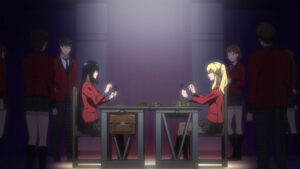 Kakegurui is set at a fictional high school for the children of the ultra wealthy elite who control business and government. The school has normal classes, but what sets it apart from normal institutions of learning is the way every after school activity involves massively high stakes gambling. From poker to roulette to far stranger and more dangerous games of chance, Hyakkaou Private Academy’s real goal is to ready these up and coming future titans of politics and industry for the tense, high stakes situations they’ll face in the real world.
Kakegurui is set at a fictional high school for the children of the ultra wealthy elite who control business and government. The school has normal classes, but what sets it apart from normal institutions of learning is the way every after school activity involves massively high stakes gambling. From poker to roulette to far stranger and more dangerous games of chance, Hyakkaou Private Academy’s real goal is to ready these up and coming future titans of politics and industry for the tense, high stakes situations they’ll face in the real world.
Coming in to this frankly bizarre setting is transfer student Yumeko Jabami. If this were any other show, Yumeko would beat back the all powerful student council who controls every aspect of school life. She’d be an unimpeachable white knight outplaying everyone in this den of vipers. Instead, though she is friendly and has good morals, Yumeko is, in some ways, the most ruthless and gambling crazed of all the academy’s students!
Yumeko doesn’t so much as bat an eye when her fellow students look down on her or others. She doesn’t care if the student council has made having gambling debt at this school akin to being a slave to your fellow students. She doesn’t give a second thought to people trying to literally take control of others’ entire lives. All she wants is the most exciting, tension-filled gambles possible. The higher the stakes the better. The few times we ever see Yumeko angry is when someone tries to intentionally lose. She doesn’t care if you cheat as long as the base rules of the game are fair as she’ll always find a way to outplay you. But rig a game so that she is sure to win? So that she doesn’t get the thrill of being on the knife’s edge of victory and defeat? That’s her biggest turn-off and she might never speak to you again!
“Deal With The Devil” the opening song for Kakegurui’s first season, is a blast. This fast paced, upbeat, jazzy number is filled to the brim with edgy, double entendre lyrics all relating to gambling. Raising the stakes. Seeing through an opponent’s strategy. Having an unbeatable hand. Etc. It’s gotta be Yumeko singing here, and she is in full control of the situation! The song is the perfect opening for a show that is, itself, wild and edgy. “Deal With The Devil” rarely if ever comes into play during the show. It seems satisfied to open each episode along side its deviously suggestive bits of animation then wait for its chance to impress all over again next episode. Speaking of that animation, it is filled with spoilers for both the first and second season. The best kind. The kind that only make sense once you watch the show. Until then, the frantic pacing of the music will more than keep you occupied.
For a long time, I thought “Deal With The Devil” was a song whose speed and lyrics stuffed with double meanings would be all but impossible to fit into English. There doesn’t seem to be enough time to convey everything as the music zooms to the next line and next verse in the blink of an eye. Boy was I wrong! Kayli ‘Kiyo’ Mills did an outstanding job of creating a completely original cover for the song that lives up to its fast paced power. My one complaint, which seems a bit embarrassing when I say it out loud, is that she fails to meow at the appropriate time! But you know what? For a show as slyly suggestive as Kakegurui… that kind of thinking is absolutely perfect!
Fuwa Fuwa Time - K-On!
 Fuwa Fuwa Time is a song whose strong introduction and many repeat performances made it THE song of an incredible anime.
Fuwa Fuwa Time is a song whose strong introduction and many repeat performances made it THE song of an incredible anime.
K-On!, the anime featuring this song, is perhaps the ultimate combination of Comedy, Slice of Life and Iyashikei (calming shows with very little drama). It stars five high school girls who join together to continue their school’s light music club… but really all they do is goof off, drink tea, eat cake, go on shopping trips, and maybe every once in a while they actually even play some music.
Somehow, what should be a show that gets dropped because nothing is happening slowly builds and builds until you’ve fallen in love with the smallest character quirks and most mundane happenings. This is a show where, by the end of the first season, a simple look down a familiar empty staircase can evoke feelings nearly as strong as the most dramatic anime around. And not because something dramatic happened. Just because that staircase is the one these characters you’ve come to love use to get to their music room where most of their antics take place.
“Fuwa Fuwa Time” is a song that comes in several different flavors. The original version of the song saw the K-On! girls switch who sang vocals because of silly happenings that left one of them with a blown out scratchy voice. Later versions switched back to the original vocalist for other silly reasons. While still later versions added another club member with a new instrument. The version I’ve chosen is actually one of the last played since it appears over the end credits of the K-On! Movie that released after the tv series. All the versions start off with an instantly recognizable guitar riff that flows into keyboard and drums that support upbeat sing song lyrics. The song is about finding the courage to express yourself to someone you secretly admire. But, really, it could be about anything. The sound of it is just so instantly catchy.
I featured the movie version of “Fuwa Fuwa Time” partially because I like the more airy, stereo separated feel of its opening, and partially because I like the way it switches lead singers back and forth between verses.
One of the reasons I think of Fuwa Fuwa Time as THE song of K-On! Is, oddly enough, because we almost never hear all of it. Instead, the show frequently features the song’s intro or outro as a way to signify the start or end of a concert or a performance without having to play and animate the entire thing. I bet the entire song is played beginning to end less than five times throughout the show’s run. But we hear pieces of it so often that I can’t hear even the first few guitar cords without immediately picturing the anime. It’s that ingrained in my mind.
Speaking of the animation, though, this song is one of the first in a line of K-On! songs to feature totally unexpected music videos. Who would expect a song about a secret admirer struggling to express hidden love would be represented by… a peace-loving outlaw hippy band performing concerts and running from both the police and the military in their 1950’s Cadillac?!
K-On! has many fantastic songs. Some are more closely related to its characters or what passes for the anime’s goofy, minimal plot. There’s one or two that probably generate stronger feelings of friendship or love, like a song about one character’s beloved sister or the group’s most treasured friend. But if you want me instantly thinking of K-On… just play me the first second or two of “Fuwa Fuwa Time” and you’ll have me nostalgic for one of anime’s most landmark shows.
Finally, as I often do, I look for a great english cover of the anime songs I love. This version by GS 1.0 hits it out of the park with full cosplay and just a great energy about the whole thing!
Bang Brave Bang Bravern
 Easily the most surprising and standout anime in the Winter 2024 season, Bang Brave Bang Bravern has me laughing out loud every week with its wacky, save the world mecha hijinks.
Easily the most surprising and standout anime in the Winter 2024 season, Bang Brave Bang Bravern has me laughing out loud every week with its wacky, save the world mecha hijinks.
Bang Braven, I guess that’s what I’ll call it, is different in tone from a serious Gundam or Macross, and while self-aware, it’s also not an SSSS.Gridman style show, either. Even though it’s dealing with largely real-world military forces (well, until it doesn’t) the show I think it feels closest to is actually Tengen Toppa Gurren Lagann. I doubt this will have a tournament arc like Gurren Lagann did, but they share a similar sort of energy, excitement, and humor.
Sometime around the modern day, American and Japanese forces are having a joint military exercise around Hawaii. Everything from aircraft carriers to ground forces to American Titanostrider mechs and Japanese equivalents are simulating a joint attack on a fortified beachhead.
And then, aliens attack.
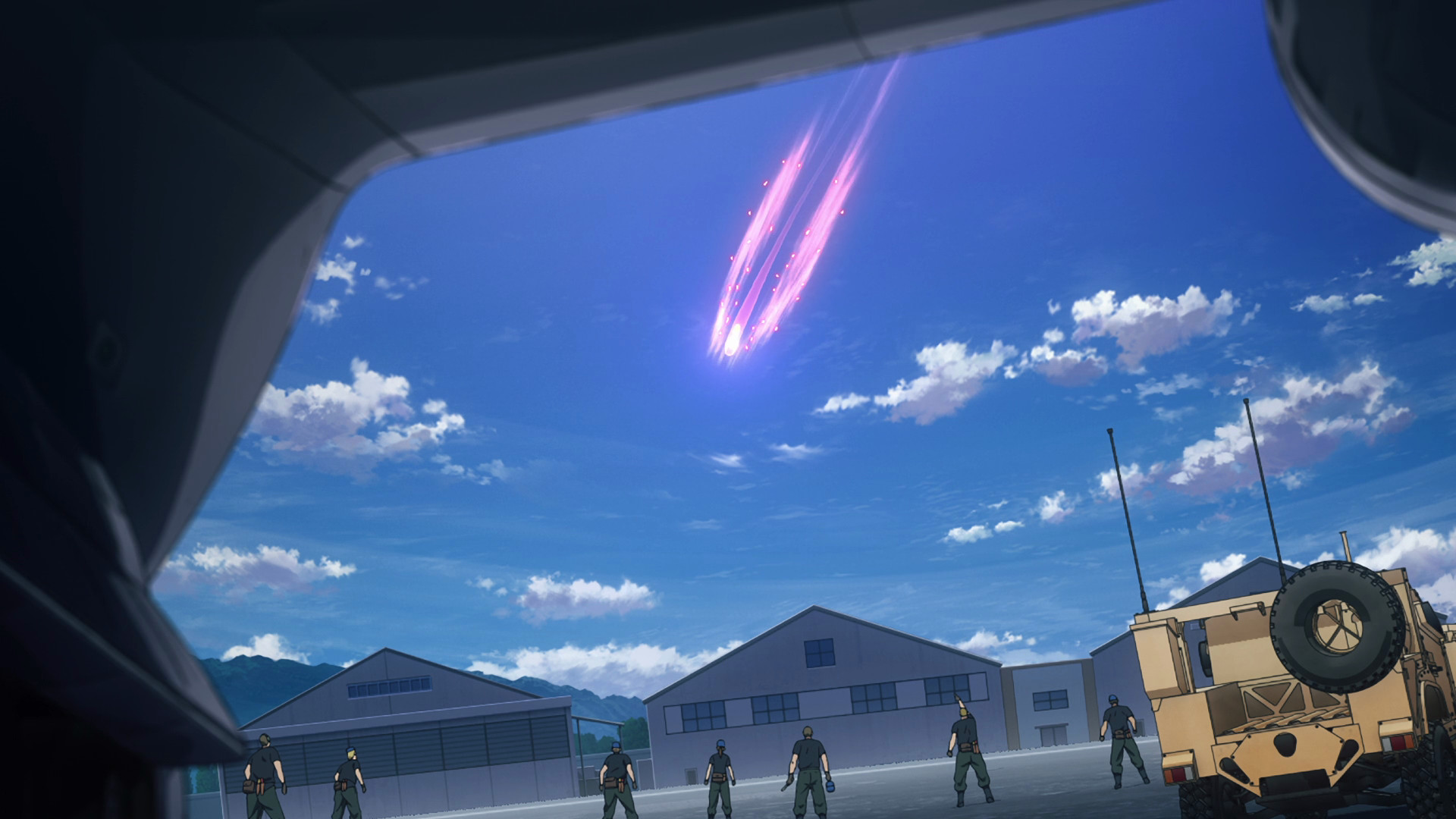
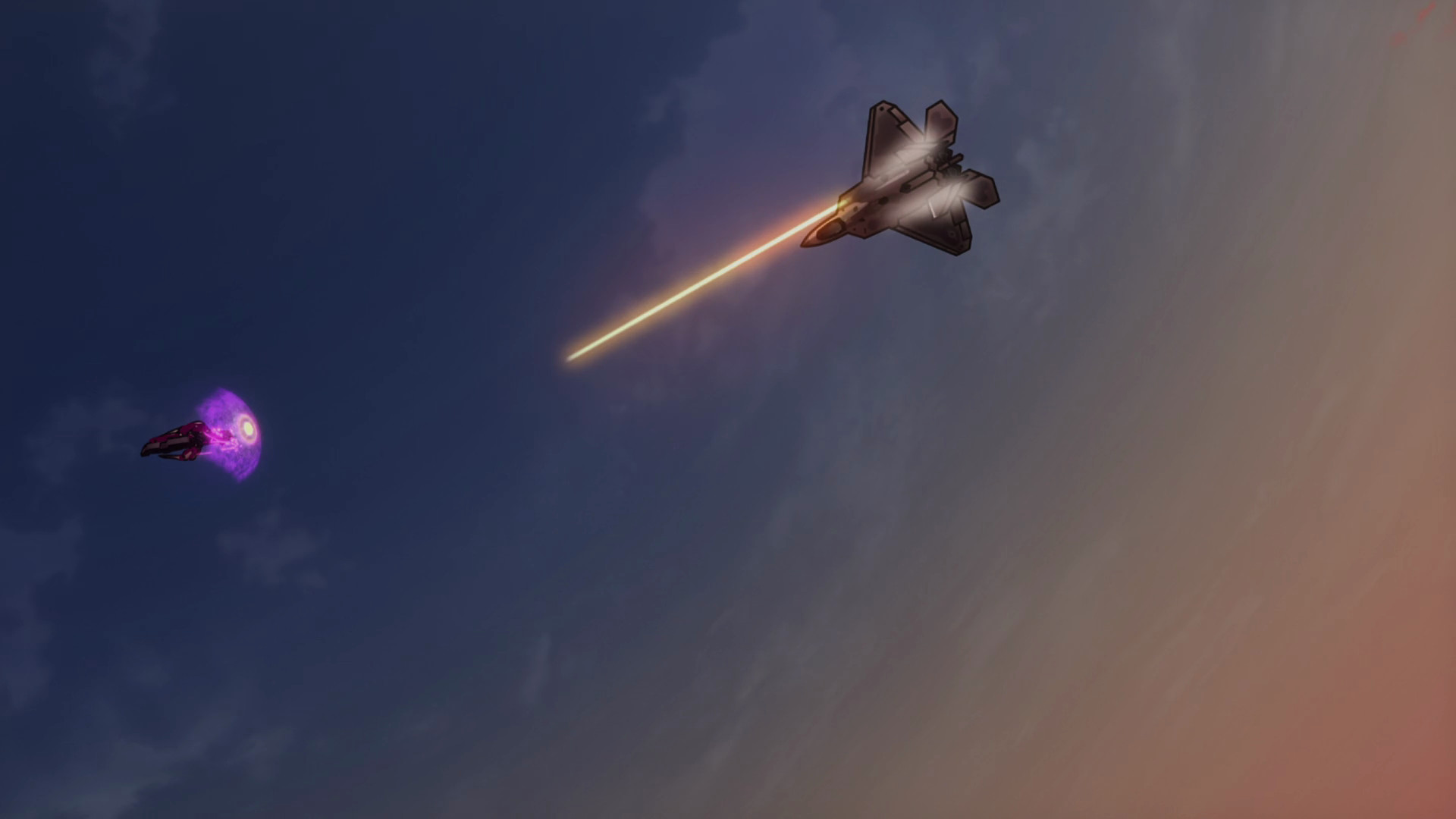
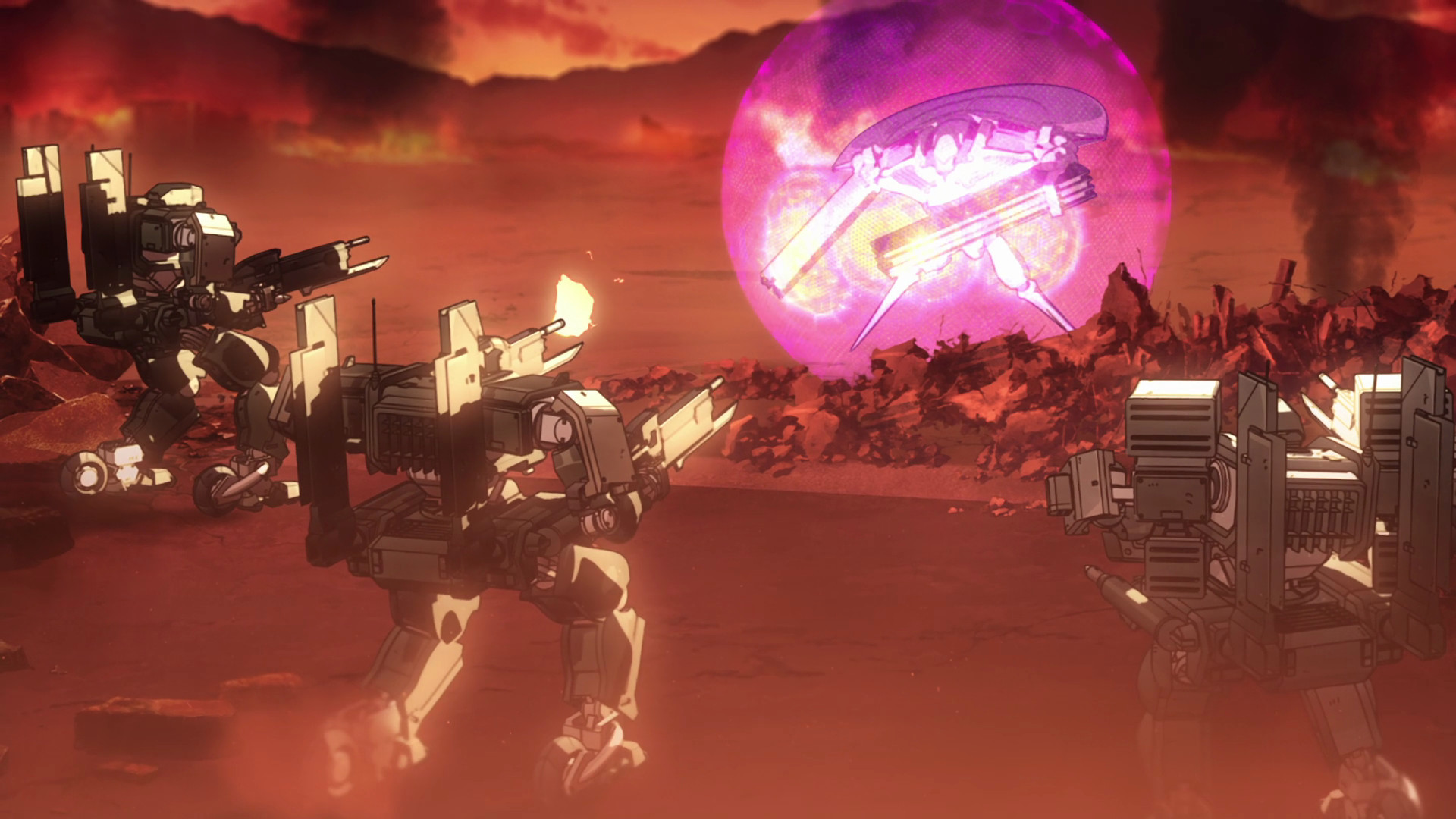
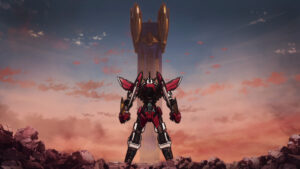 Even our best soldiers and most powerful machines are all but useless against the shielded alien mechs that descend from space and soon blanket the entire world similar to Independence Day. The situation looks all but lost for our heroes in Hawaii, but then, at the last moment, a red, blue, and white talking mech saves the day and takes in one of the Japanese mecha pilots as its pilot.
Even our best soldiers and most powerful machines are all but useless against the shielded alien mechs that descend from space and soon blanket the entire world similar to Independence Day. The situation looks all but lost for our heroes in Hawaii, but then, at the last moment, a red, blue, and white talking mech saves the day and takes in one of the Japanese mecha pilots as its pilot.
This new mech is named Bravern. Bravern is loud. Bravern is bombastic. Bravern encourages his new pilot, Isami Ao, yell out the names of super attacks along with him. With Bravern’s help, the surviving joint forces are able to push back the aliens around Hawaii. And then things get even crazier.
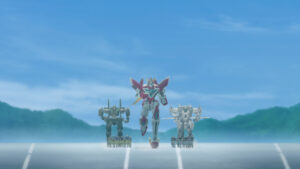 Unlike most other mecha shows, where the gundams, or similar mechs, are just stationary machines without their pilots, Bravern himself remains very much a character after the battle ends. Though Bravern’s head is multiple the size of an entire human, he participates in strategy meetings. He leads the joint forces in exercise routines that include runs and pushups for the humans and their machines. He leads training courses on, complete with an overhead projector, showing the joint forces how to overwhelm the enemy’s shields. Bravern is such a fun character he pretty drives the show much like Kamina did for Gurren Lagann.
Unlike most other mecha shows, where the gundams, or similar mechs, are just stationary machines without their pilots, Bravern himself remains very much a character after the battle ends. Though Bravern’s head is multiple the size of an entire human, he participates in strategy meetings. He leads the joint forces in exercise routines that include runs and pushups for the humans and their machines. He leads training courses on, complete with an overhead projector, showing the joint forces how to overwhelm the enemy’s shields. Bravern is such a fun character he pretty drives the show much like Kamina did for Gurren Lagann.
 That doesn’t mean we don’t have other good characters. Pilot Isami Ao has so far been a reluctant pilot of the brash Bravern. There is some bond between them that hasn’t been fully explored yet. There’s also Lewis Smith, one of the American pilots who wishes he could operate Bravern, but Bravern will not let him for some reason. Again, something about that bond between Bravern and Isami. Maybe some sort of past battles they shared in space that Isami has since forgotten about? Minor characters include the joint forces commander. And the airborne command and control operators who direct our heroes into battle.
That doesn’t mean we don’t have other good characters. Pilot Isami Ao has so far been a reluctant pilot of the brash Bravern. There is some bond between them that hasn’t been fully explored yet. There’s also Lewis Smith, one of the American pilots who wishes he could operate Bravern, but Bravern will not let him for some reason. Again, something about that bond between Bravern and Isami. Maybe some sort of past battles they shared in space that Isami has since forgotten about? Minor characters include the joint forces commander. And the airborne command and control operators who direct our heroes into battle.
Whatever secrets the show is holding on to for now, it is just hilarious and a joy to watch. And not just for the humor that makes it good. This week’s episode had a touching moment where a bunch of the soldiers and technicians Isami helped save in the opening battle got to thank him and buy him drinks. Lewis Smith is having to deal with not being the superhero pilot after being rejected by Bravern. We also got a glimpse of the allied forces’ first counterattack location, and it was kinda gut wrenching to see these soldiers and technicians in shock over the battering their homelands have taken.
 The show is not going to instantly appeal to everyone. It is fairly silly and tongue in cheek despite some of its more serious, straightforward military trappings. But for anyone willing to have a bit of knowing fun thrown into their serious military mecha show, there’s nothing in recent memory that can top this.
The show is not going to instantly appeal to everyone. It is fairly silly and tongue in cheek despite some of its more serious, straightforward military trappings. But for anyone willing to have a bit of knowing fun thrown into their serious military mecha show, there’s nothing in recent memory that can top this.
Also, the ending credits of each episode. Neither words nor a single image can do them justice. Just… wow.
Ensemble for Polaris - Vivy: Fluorite Eye's Song
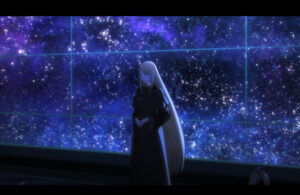 Vivy -Fluorite Eye’s Song- follows the character Diva, a newly created artificial intelligence in a robot body. Like all AI’s in this anime, Diva was given a singular main task to perform. AIs in this world come in a huge ranges of shapes and sizes built for specific purposes. Some are music teachers. Some are vacuum cleaning drones. Diva was created as a songstress and told to make people happy with her singing and then told that to accomplish her goal she’d have to sing from her heart.
Vivy -Fluorite Eye’s Song- follows the character Diva, a newly created artificial intelligence in a robot body. Like all AI’s in this anime, Diva was given a singular main task to perform. AIs in this world come in a huge ranges of shapes and sizes built for specific purposes. Some are music teachers. Some are vacuum cleaning drones. Diva was created as a songstress and told to make people happy with her singing and then told that to accomplish her goal she’d have to sing from her heart.
The show soon sets Diva on an exciting one hundred year mission involving time travel and a world ending AI uprising that she is tasked with stopping. Diva gains a talkative know-it-all AI partner, and hand to hand combat skills, and far more knowledge about life and death than she ever wanted, but throughout it all, she continues to struggle with the question of how to make people happy with her singing, and how an AI like her can possibly truly sing from her heart.
“Ensemble for Polaris” is one of the few songs Diva does not sing. Instead it is first sung by Estella, a caretaker AI hostess who tends to the needs of her guests aboard Sunrise, an orbital resort space hotel she runs. This slow, almost haunting tale about space and the mythical beings that inhabit it searching for and finding each other is first sung to calm and wow a room full of Estella’s human guests. The song comes back later during a moment of high tension where it’s themes of two lost souls finding one another becomes even more relevant.
“Ensemble for Polaris” doesn’t quite represent Vivy in the same way that “Moonlight Densetsu” can be said to represent Sailor Moon. If you want that, Vivy’s “Sing My Pleasure” is kinda it’s overarching theme song. But this song was one of the first big examples of music being used in the show to change people’s lives for the better. The way it was used at the end of the 4th episode brought real tears to my eyes and had me rush to tell my friends that I’d found a new great anime.
Anime where music plays an outsized, in-universe roll is… kinda my thing. 🙂
Moonlight Densetsu - Sailor Moon
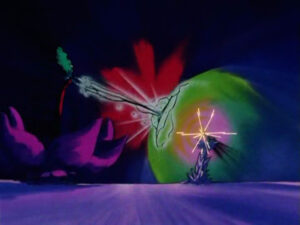 The first song I can remember as being from an anime has to be the english version of Sailor Moon’s “Moonlight Densetsu”. Sailor Moon, itself, was, back then, this strange cartoon with super powered girls fighting scary monsters while trying to live out their normal lives. There were awesome elemental attacks, and cool transformations, and ultimate finishing moves. And this song kicked all that off each episode.
The first song I can remember as being from an anime has to be the english version of Sailor Moon’s “Moonlight Densetsu”. Sailor Moon, itself, was, back then, this strange cartoon with super powered girls fighting scary monsters while trying to live out their normal lives. There were awesome elemental attacks, and cool transformations, and ultimate finishing moves. And this song kicked all that off each episode.
But, more than that, the Sailor Moon theme song was the battle music that played in the final confrontation of the evil queen vs Sailor Moon representing the last guardian standing between earth and ultimate evil. Watching tiny Usagi hold her ground against the overwhelming attacks of Queen Beryl is kinda my first and maybe best memory of good fighting back against evil. Queen Beryl shouts about how the world is already filled with filth and hate, but Usagi responds that she believes in the world and in her friends. It’s a theme played out so many times in so many different anime, but for me, its starts here with those first guitar riffs of Moonlight Densetsu!
The song itself is interesting because even though it is the key bit of music used in the first season’s final battle of good against evil… it’s not all that upbeat and its lyrics have very little to do with such an epic struggle. Instead, it’s the soft focus, dreamy, angsty musings of a teenage girl happy to be born on the same planet as the boy she is in love with. But for something so unsuited to dark lightning being repelled by a shrinking bubble of light… it actually fits plenty well. The themes in that final battle, of hope and love overcoming evil, are kinda exemplified by these innocent musings of a girl in love.
In the years and decades since, I’ve found that the version I fell in love with is the english remake of the original Japanese song. And while I respect the original a ton, there’s something about that english version set to the cuts of the english Sailor Moon opening that still excites me to this day. Usagi does this little slashing move with the silver crystal beating back Queen Beryl’s dark lightning attack and in that one instant the song and animation comes together for me in a moment of iconic perfection.
That said, I more often listen to the original and to AmaLee’s fantastic english cover. Both instantly send me back to that fight of good vs evil in some of my earliest days of watching anime!
Episode 6 of Bunny Girl Senpai Might Have The Most Wholesome Twist Ever
I’ve been watching back through Bunny Girl Senpai and just re-finished Tomoe Koga’s arc. I’d forgotten how good it was. Both in the way it played out but I’d really forgotten the way it ended! I gasped when the endgame started and couldn’t help the big smile on my face as the show kept pilling on more and more happiness.
 For the last three episodes, Sakuta has been acting as Tomoe’s boyfriend so as to help her avoid being asked out by a guy who her friend has a crush on. Being asked out would not only hurt her friend, it would disrupt Tomoe’s own precarious spot in her class’ social groupings. Almost everything she’s done over her first year in high school has been to fit in. She is constantly on her phone keeping up with her friends in their chat group. She changed her look and manner of speech when she moved to the big city for high school. And now she’s taken on a fake boyfriend in Sakuta. Her goal was to hang out with him for a few weeks and then have a public breakup so they could both go their separate ways. No entanglements. No complications. But her heart didn’t see it that way.
For the last three episodes, Sakuta has been acting as Tomoe’s boyfriend so as to help her avoid being asked out by a guy who her friend has a crush on. Being asked out would not only hurt her friend, it would disrupt Tomoe’s own precarious spot in her class’ social groupings. Almost everything she’s done over her first year in high school has been to fit in. She is constantly on her phone keeping up with her friends in their chat group. She changed her look and manner of speech when she moved to the big city for high school. And now she’s taken on a fake boyfriend in Sakuta. Her goal was to hang out with him for a few weeks and then have a public breakup so they could both go their separate ways. No entanglements. No complications. But her heart didn’t see it that way.
 She developed a crush on Sakuta despite her sincere wishes for them to part ways and remain friends. This leads to the arc’s second time loop. Sakuta and Tomoe loop through their final date together four or five times before he finally gets her to be honest with herself and admit her true feelings. It’s a great little scene on its own, with Tomoe recounting the ways things should go. They’ll make a show of breaking up. She’ll help him get with his real girlfriend. And she and Sakuta will become best friends who can laugh about how fun this silly fake dating scheme was at the time. Except Tomoe isn’t laughing. Each time the day ends her heart longs for Sakuta a little more. And each morning she wakes up at the beginning of the same day, secretly hopeful that he is falling a little more for her just as each time she loops she falls just a little more for him. The time loop ends for real when Sakuta forces her to confront her true feelings. With tears running down her face Tomoe makes a heartfelt declaration of love to Sakuta which he gently turns down. Love hurts but is necessary.
She developed a crush on Sakuta despite her sincere wishes for them to part ways and remain friends. This leads to the arc’s second time loop. Sakuta and Tomoe loop through their final date together four or five times before he finally gets her to be honest with herself and admit her true feelings. It’s a great little scene on its own, with Tomoe recounting the ways things should go. They’ll make a show of breaking up. She’ll help him get with his real girlfriend. And she and Sakuta will become best friends who can laugh about how fun this silly fake dating scheme was at the time. Except Tomoe isn’t laughing. Each time the day ends her heart longs for Sakuta a little more. And each morning she wakes up at the beginning of the same day, secretly hopeful that he is falling a little more for her just as each time she loops she falls just a little more for him. The time loop ends for real when Sakuta forces her to confront her true feelings. With tears running down her face Tomoe makes a heartfelt declaration of love to Sakuta which he gently turns down. Love hurts but is necessary.
And then we’re back to the same shot of Sakuta’s apartment building with the trees in the foreground that we’ve seen these past four or five final date loops. As a viewer am thinking: “Ok, show. I see what you are doing. You’re making me think the loop didn’t end, but you’ll cut to a clock or calendar or something and confirm that, yes, Tomoe’s tearful admission really did let she and Sakuta move on to tomorrow.”
Except that’s not what happens.
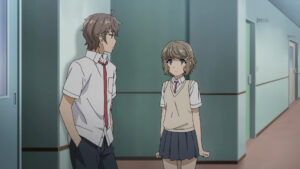 Instead of cutting inside to the anticipated clock or calendar, we cut to the newscast of the soccer tournament results that marked the repetition of Sakuta and Tomoe’s first time loop! The one that was happening some three weeks before! Instead of moving forward into the long awaited tomorrow, the show takes Sakuta almost a month back into the past! But for the cutest, most wholesome reasons!
Instead of cutting inside to the anticipated clock or calendar, we cut to the newscast of the soccer tournament results that marked the repetition of Sakuta and Tomoe’s first time loop! The one that was happening some three weeks before! Instead of moving forward into the long awaited tomorrow, the show takes Sakuta almost a month back into the past! But for the cutest, most wholesome reasons!
It turns out that everything that Sakuta had experienced over the last three weeks was all a part of Tomoe’s “laplace’s demon” simulation of the future. Now, Sakuta gets to live through the three week period a second time knowing most everything that will happen. He again gains Tomoe as a coworker at his job. He again helps her friend find her phone charm. He again gets to see his sister’s eyes sparkle as she accepts her gifted new outfit. He again gets to study with Mai dressed in her bunny girl outfit. And this time aces his midterms instead of failing them because he’s already seen the questions. And, of course, most critically, he uses his knowledge of Mai’s responses to earn himself official boyfriend status and even a kiss from Mai.
 What could have just been a perfectly great cathartic resolution to Sakuta and Tomoe’s story arc instead turned into three weeks of good luck granted to Sakuta for all his selflessness and hard work! All handed to me, the viewer, through one of the best double fake outs I can remember.
What could have just been a perfectly great cathartic resolution to Sakuta and Tomoe’s story arc instead turned into three weeks of good luck granted to Sakuta for all his selflessness and hard work! All handed to me, the viewer, through one of the best double fake outs I can remember.
Well done, show. Well done! It’s this kind of amazing writing and execution that makes Rascal Does Not Dream of Bunny Girl Senpai a sparking diamond in the rough.
2022 Was A Great Year for Anime
2022 was a great year for anime. I don’t think I’ve experience a year this good since the phenomenal 2018 which gave us shows like:
- A Place Further Than The Universe
- Violet Evergarden
- Revue Starlight
- Rascal Does Not Dream of Bunny Girl Senpai
- SSSS.Gridman
- Maquia: When the Promised Flower Blooms
What 2022 gave us was both some wildly popular mainstream shows, and a fair number of excellent shows that came in out of nowhere or were just plain happy to exist off the beaten path. One thing that made me extra happy this year were the number of shows centered around music and personal creativity.
Here’s the shows I enjoyed most in 2022:
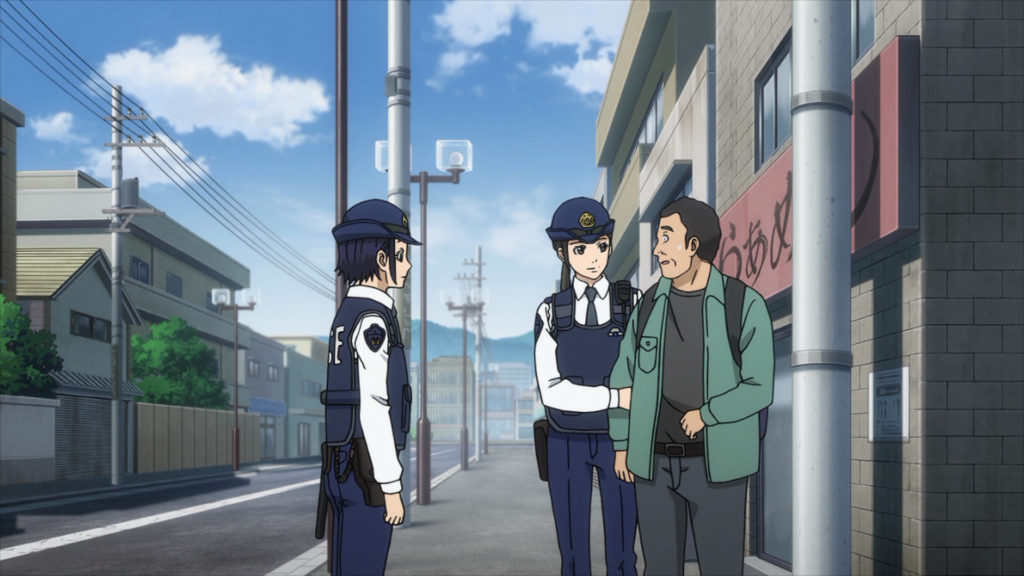 Police in a Pod – This police slice of life anime that sprung from the mind of a former real life Japanese patrol officer somehow manages to be both amusing and all too real. It follows the lives and happenings surrounding two patrol officers working out of a small neighborhood police station and features a wide variety of on the job and off the job situations the two must tackle.
Police in a Pod – This police slice of life anime that sprung from the mind of a former real life Japanese patrol officer somehow manages to be both amusing and all too real. It follows the lives and happenings surrounding two patrol officers working out of a small neighborhood police station and features a wide variety of on the job and off the job situations the two must tackle.
The show mixes the joys of rescuing victims of abuse and catching criminals who think they are too clever to be caught with the real challenges and hardships officers go through in an effort to live their lives and keep their sanity while working in a system that doesn’t always have their best interests in mind. Everything from simple patrols, to search and rescues, to responding to troubling calls like domestic violence and suicides is represented here. The dialogue is witty without being annoying or “Marvel snappy”. And the institutional knowledge on display is fabulous, even if the animation budget was a size or so too small.
 Akebi’s Sailor Uniform – As discussed at length in my review, this show is a modern classic. It’s an animator’s anime that takes joy in depicting the motions and emotions inherent in young teenager Komichi Akebi’s life as she goes to school, plays sports, and makes lots and lots of friends.
Akebi’s Sailor Uniform – As discussed at length in my review, this show is a modern classic. It’s an animator’s anime that takes joy in depicting the motions and emotions inherent in young teenager Komichi Akebi’s life as she goes to school, plays sports, and makes lots and lots of friends.
While it may never be as outwardly flashy as the effects-heavy combat animations in popular action anime, the artwork and artistry this show has to offer is, in many ways, second to none. The way the show combines that with a full class of interesting characters and a great soundtrack makes me think it will long be remembered.
 My Dress-up Darling – Cosplay, dressing up as your favorite characters from tv or games or movies, is a popular pass time. But also one that is expensive and takes a good deal of skill to pull off successfully. Energetic, outgoing hipster Marin Kitagawa knows this all too well when her efforts to design a costume in an effort to become her favorite game character fails miserably. But then she meets the reserved Wakana Gojo at her high school one evening. His talents at designing outfits for tiny hina dolls for his family business sees him get roped in to be her cosplay costume designer.
My Dress-up Darling – Cosplay, dressing up as your favorite characters from tv or games or movies, is a popular pass time. But also one that is expensive and takes a good deal of skill to pull off successfully. Energetic, outgoing hipster Marin Kitagawa knows this all too well when her efforts to design a costume in an effort to become her favorite game character fails miserably. But then she meets the reserved Wakana Gojo at her high school one evening. His talents at designing outfits for tiny hina dolls for his family business sees him get roped in to be her cosplay costume designer.
What follows is a remarkably wholesome budding romance between these two lead characters, even though Marin’s greatest wish is to dress up as some surprisingly provocative figures from her favorite games and tv series. Respect, recognition of effort, and acknowledging one another’s boundaries and dreams play just as large a role in this romance anime as the crazy, and often revealing, costumes Marin commissions from Wakana.
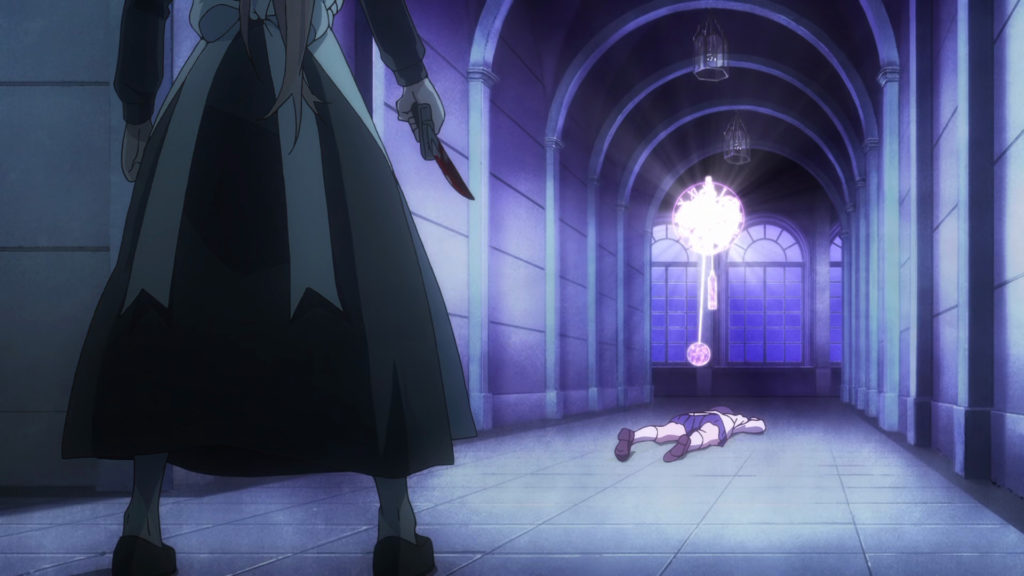 The Executioner and Her Way of Life – There’s a genre of anime called “Isekai”, a word which means “different world”, which revolve around the core premise of a normal guy or girl from our modern world being transported to some kind of alternate fantasy world where they often gain impossible abilities and become the hero destined to save the day. There’s a lot of these. So many that copy cats and uninspired efforts sometimes give bad name to the good examples of the genre.
The Executioner and Her Way of Life – There’s a genre of anime called “Isekai”, a word which means “different world”, which revolve around the core premise of a normal guy or girl from our modern world being transported to some kind of alternate fantasy world where they often gain impossible abilities and become the hero destined to save the day. There’s a lot of these. So many that copy cats and uninspired efforts sometimes give bad name to the good examples of the genre.
This show is one of those good ones mostly for the way it flips the concept on its head. In this particular fantasy world, people from our modern day Japan get summoned across dimensions and gain great magical powers, but those powers are just as often unbelievably dangerous as they are helpful. So, there exists a whole sect devoted to finding these would be heroes/villains/natural disasters and ending them before they can become a threat to themselves or others.
Our main character, priestess Menou, is tasked with killing newly transported innocent schoolgirl Akari Tokitō whose new innate powers of time manipulation are so dangerous they threaten everyone and everything. There’s just one problem: Akari is so powerful that she cannot be killed. Even a successful surprise assassination from Menou early in the series just sees Akari’s time powers turn back the clock on her own body so her fatal injuries are undone.
In order to save the world, these two characters come to form an unlikely friendship based on the mutual desire to find a way to kill Akari before her powers spiral out of control and break time itself. The show features fun characters and a good plot twist or two that make it all worth watching.
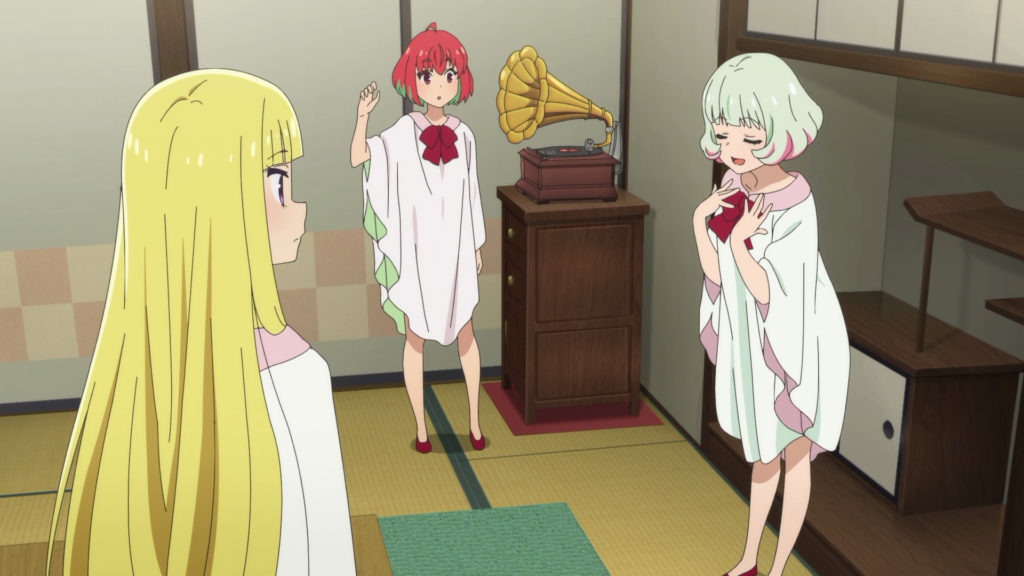 Healer Girl – In our modern day, the science of musical healing is beginning to join more traditional medical techniques for treating patients. We follow three up and coming musical healers as they apprentice at a local clinic and seek to earn their professional licenses.
Healer Girl – In our modern day, the science of musical healing is beginning to join more traditional medical techniques for treating patients. We follow three up and coming musical healers as they apprentice at a local clinic and seek to earn their professional licenses.
This show is fun, colorful, and surprisingly musical. The three main character, of course, sing to do things like heal minor injuries or support surgeons during surgery, but singing is so innately a part of their lives that they do it all the time. This leads to fun segments of the girls singing out their life-long motivations or singing out technical musical terms for an upcoming exam while they clean their clinic. While it doesn’t have the biggest budget and there’s no particular conflict to keep you glued to your tv, this show provided me with enough wholesome musical fun to keep me watching week to week.
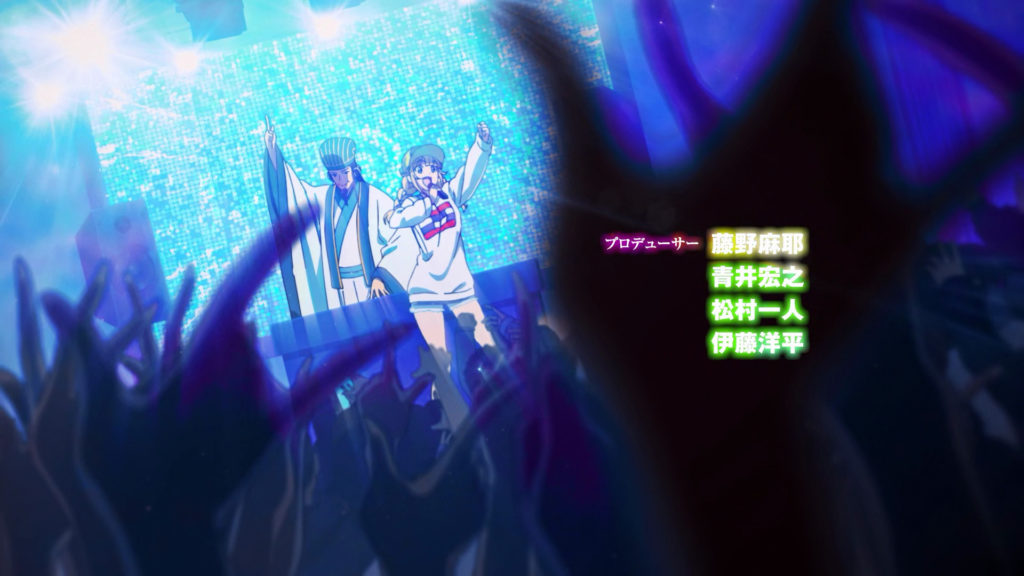 Ya Boy Kongming – Speaking of music, this show with its concept of ancient Chinese military strategist Zhuge Liang Kongming reawakening in modern day Japan in order to devise clever marketing strategies for an unknown club singer named Eiko Tsukimi just seemed far too odd for people to give it a chance. And then everyone saw it’s glorious opening with it’s crazy, upbeat music and outstandingly artsy animation and we were all hooked.
Ya Boy Kongming – Speaking of music, this show with its concept of ancient Chinese military strategist Zhuge Liang Kongming reawakening in modern day Japan in order to devise clever marketing strategies for an unknown club singer named Eiko Tsukimi just seemed far too odd for people to give it a chance. And then everyone saw it’s glorious opening with it’s crazy, upbeat music and outstandingly artsy animation and we were all hooked.
Spectacular, fortune-changing opening aside, this show kept its audience around by being a surprisingly well put together story of an unknown talent climbing the music charts to starhood while making friends and changing lives for the better along the way. If you liked Carole & Tuesday, you’ll like this too. It’s got music. It’s got heart. It’s got better art than I initially expected. It’s got one of the best anime openings of all time. What more do you really need?!
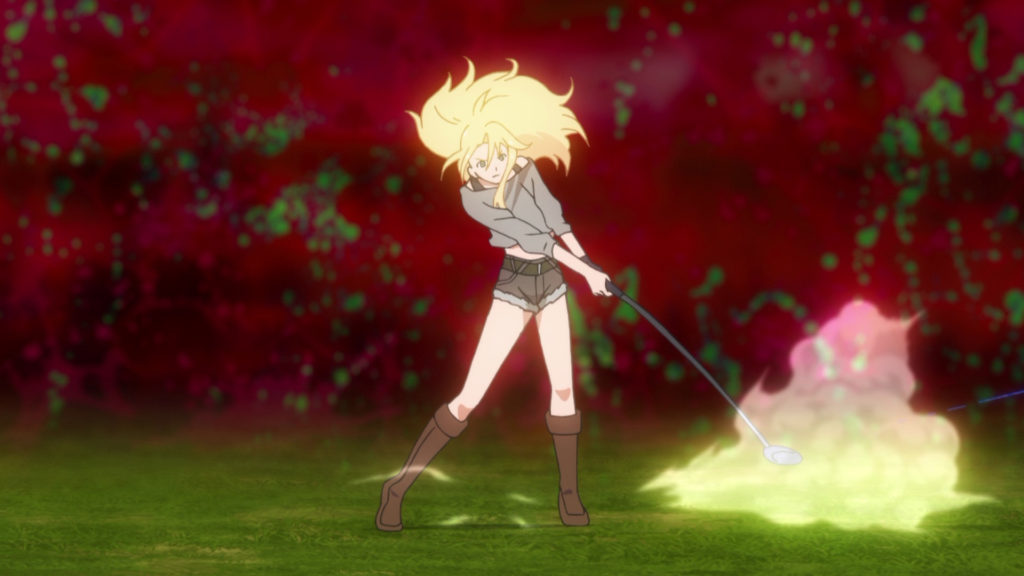 Birdie Wing: Golf Girls’ Story – Imagine the perfect golf anime. Stunningly detailed lakes and sand traps and fairways and brilliant blue skies. Extremely well animated swings. Intense on course rivalries. That perfect clinking sound of sinking a long, difficult putt. Now… mix in a hefty does of the extremely over the top gambling anime Kakegurui and add a dash of… I don’t know, something insane like Kill la Kill or Gurren Lagann… then stir vigorously. That’ll just about get you to Birdie Wing.
Birdie Wing: Golf Girls’ Story – Imagine the perfect golf anime. Stunningly detailed lakes and sand traps and fairways and brilliant blue skies. Extremely well animated swings. Intense on course rivalries. That perfect clinking sound of sinking a long, difficult putt. Now… mix in a hefty does of the extremely over the top gambling anime Kakegurui and add a dash of… I don’t know, something insane like Kill la Kill or Gurren Lagann… then stir vigorously. That’ll just about get you to Birdie Wing.
This is a crazy story of a female golfer named Eve who yells out the names of powerful secret swing techniques taught to her by a departed golf master. She plays illicit rounds of golf against wealthy, overconfident would-be rivals who bet against her often in opposition to the wishes of the cutthroat international golf mafia. She does this so she can humiliate everyone involved and pocket large sums of money so she can continue to protect her bar where she and her friends take care of a needy group of orphans. All of which goes well until Eve finally meets a true rival in the endlessly calm and collected Aoi Amawashi who herself is the offspring of two golfing legends. Aoi has become enslaved in corporate sponsorships thanks to her overbearing CEO of a mother and she too is in the sights of the golf mafia. Eve and Aoi become infatuated with each other’s skill and personality the first time they meet and soon join forces to take down the golf mafia and the invasive corporate powers ruining their lives.
Uh… yeah, this show is out of its mind. Which probably makes it the best possible golf anime that can be made!
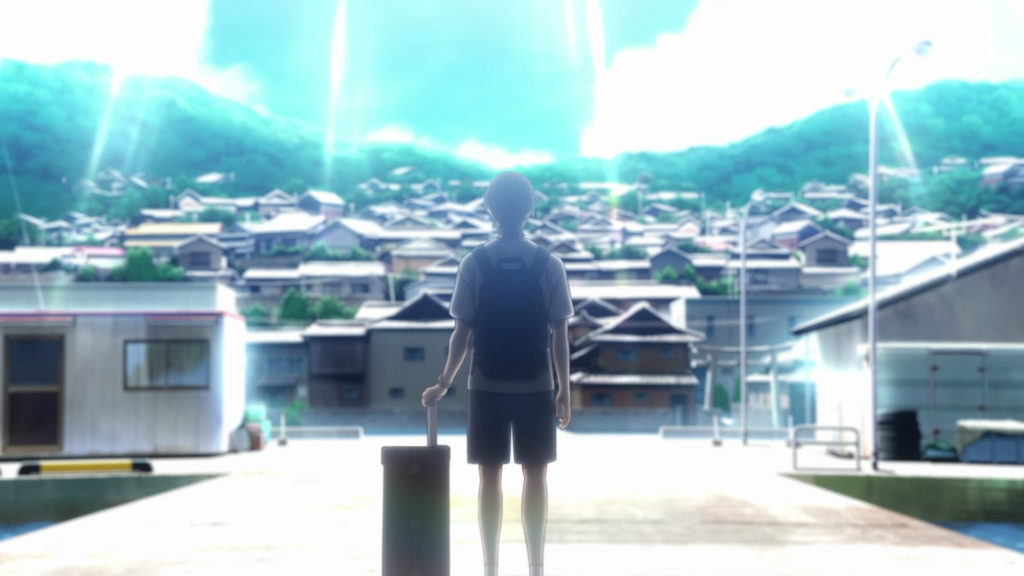 Summer Time Rendering – High school aged Shinpei Ajiro is returning home to his small Japanese island town in order to attend the funeral of his similarly aged adoptive sister Ushio Kofune who recently died in a drowning accident.
Summer Time Rendering – High school aged Shinpei Ajiro is returning home to his small Japanese island town in order to attend the funeral of his similarly aged adoptive sister Ushio Kofune who recently died in a drowning accident.
Except, maybe it was no accident. And maybe the supernatural was involved. By the end of the first episode Shinpei ends up getting murdered only to awaken a few days earlier back on the ferry he rode in on… and the expansive, intersting story goes from there. The animation is excellent. The characters are great. The story is well plotted. And I’m not gonna talk about any more of it… Just go watch it, already!
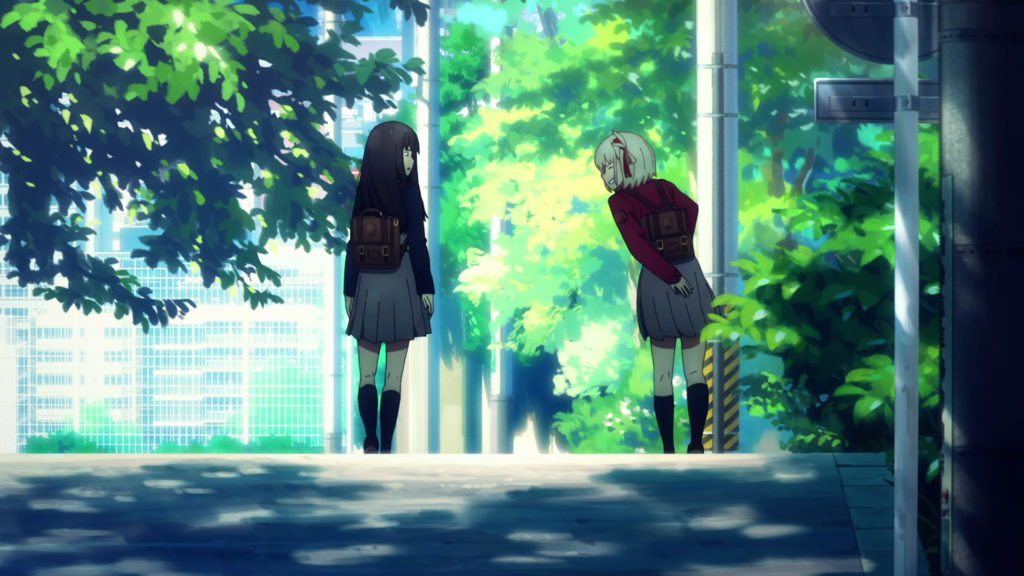 Lycoris Recoil – Modern day Japan is a nice safe place because it is a country of nice, caring people. Well, that, and because the government runs a miniature army of “Lycoris”, highly trained assassins disguised as schoolgirls, who are constantly on undercover patrols killing any and all bad guys before they can threaten anyone.
Lycoris Recoil – Modern day Japan is a nice safe place because it is a country of nice, caring people. Well, that, and because the government runs a miniature army of “Lycoris”, highly trained assassins disguised as schoolgirls, who are constantly on undercover patrols killing any and all bad guys before they can threaten anyone.
The show follows top Lycoris Chisato Nishikigi and her recently demoted partner Takina Inoue as they work out of a small cafe and help everyday people solve larger than life problems. Chisato is what made this anime great. She is upbeat, excitable, and very nearly hyperactive. Her refreshing outlook on life sees her try to fully enjoy her each and every moment but also sees her unwilling to kill because she does not wish to take similar precious moments away from anyone… even bad guys. It’s a philosophy she spends the entire show imparting on her new, grumpy, by the book protégé, Takina.
Highly enjoyable characterizations and some excellent animation made this a must watch series, even if the entire concept was a bit odd.
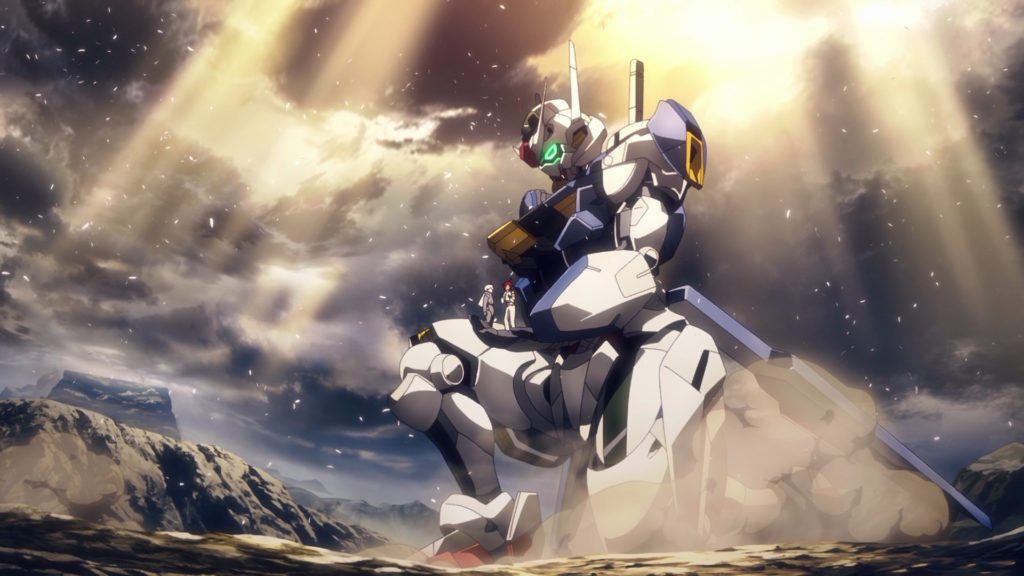 Mobile Suit Gundam: The Witch from Mercury – Marketed as the first of the long running Gundam series to feature a female lead character, Witch From Mercury is not your typical Gundam show in more ways than one. It starts with a hard hitting prologue and then switches gears to something of a space high school setting where our lead character, Suletta Mercury, seems like the outer space version of a country bumpkin dropped into an odd mix of petty school cliques, intense Earthian vs Spacian economic rivalries, and high stakes corporate politics. Oh, and Suletta and her mother at first seem to know nothing of the tragic prologue they were both very much a part of!
Mobile Suit Gundam: The Witch from Mercury – Marketed as the first of the long running Gundam series to feature a female lead character, Witch From Mercury is not your typical Gundam show in more ways than one. It starts with a hard hitting prologue and then switches gears to something of a space high school setting where our lead character, Suletta Mercury, seems like the outer space version of a country bumpkin dropped into an odd mix of petty school cliques, intense Earthian vs Spacian economic rivalries, and high stakes corporate politics. Oh, and Suletta and her mother at first seem to know nothing of the tragic prologue they were both very much a part of!
This show features awesome giant robot fights, a suspiciously idealistic main character, and a plot that seems to know what it’s doing but at the same time plays its cards very close to its chest. It’s up to the viewer to pick out the little discrepancies strewn about the episodes that makes this outwardly happy show into something much more intense and horrifying that it first appears.
Admittedly, this show is only at its halfway point, and it could totally take a bad, unsatisfying turn in its second half this Spring. But, for now at least, it’s a hands down smashing example of a show that trusts its audience to dig into its story and find the hints that it is constantly dropping. I love that kind of thing!
 Do It Yourself – Set in a slightly more high tech Japan filled with helpful AI pet robots and quadcopter drones that fill the skies each day as they deliver orders to people’s houses, this show is actually a celebration of putting love and attention in to making things by hand.
Do It Yourself – Set in a slightly more high tech Japan filled with helpful AI pet robots and quadcopter drones that fill the skies each day as they deliver orders to people’s houses, this show is actually a celebration of putting love and attention in to making things by hand.
The show opens with klutzy, high schooler Serufu Yua finding herself at odds with her childhood friend and neighbor Miku Suride. The two are being spit up as they are about to start their first day at different high schools. Serufu is going to a traditional school, while Miku is going to be attending a high tech academy. In an effort to fix their ailing friendship, Serufu ends up joining her school’s Do It Yourself club and starts in on rebuilding a wooden bench that used to sit between their houses.
Along with the injury prone Serufu and her slightly stuck up friend comes a delightful cast of characters all who join the DIY club for different reasons. By the end, they are all participating in making some excellently envisioned arts and crafts to promote their club.
In addition to fun characters and a nice, low-key story, this anime has also gotten a lot of praise for it’s somewhat stylized approach to art and animation. It’s nowhere near flashy as some shows, but apparently a lot of work went into creating and maintaining its complex shot composition and semi-watercolor look.
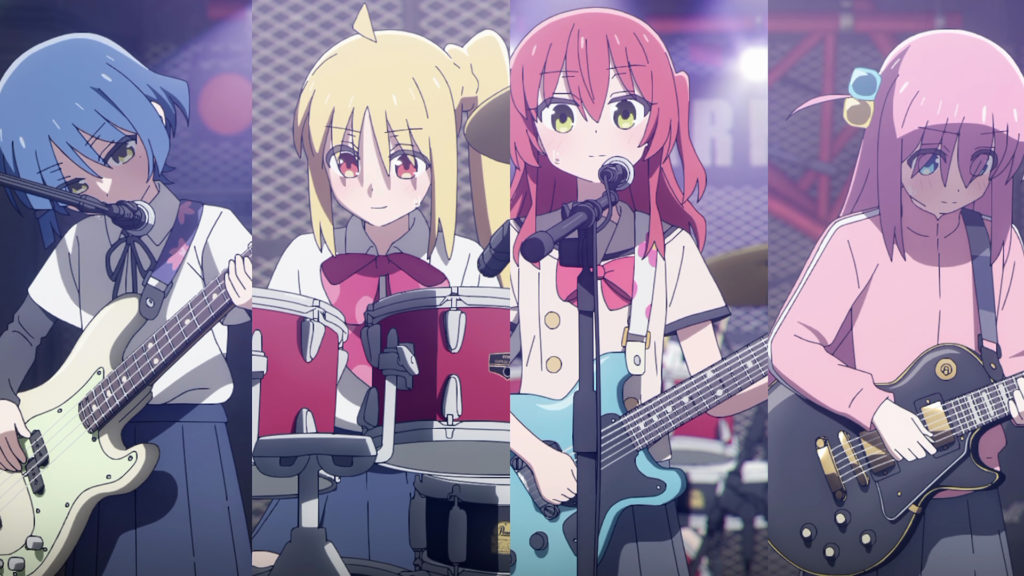 Bocchi the Rock! – At first glance, this show has been done before. Four girls joke and laugh and bond as they throw around tons of witty dialogue whilst forming a band? This show is just K-On! Except, it isn’t. Not at all. Instead, what this fascinating anime provides is a feast of crazy animation and film making techniques that explore the inner thoughts and worries of lead character Hitori “Bocchi” Goto as she is dragged outside her incredibly lonely comfort zone when she is invited to join an after school band.
Bocchi the Rock! – At first glance, this show has been done before. Four girls joke and laugh and bond as they throw around tons of witty dialogue whilst forming a band? This show is just K-On! Except, it isn’t. Not at all. Instead, what this fascinating anime provides is a feast of crazy animation and film making techniques that explore the inner thoughts and worries of lead character Hitori “Bocchi” Goto as she is dragged outside her incredibly lonely comfort zone when she is invited to join an after school band.
Without Bocchi as its lead character, this woud be a show very similar to K-On!. Just one with its characters much more focused on actually forming a band instead of listlessly goofing off and drinking tea. But with Bocchi as its lead, the show is instead this weird, wild, detailed and all too relatable portrayal of how someone with lifelong crippling social anxiety acts and thinks. Bocchi is prone to getting lost in her overwhelming worries and delusional flights of fancy whenever she has to interact with others. The animators put a ton of time and energy into finding ever more inventive ways to portray her inner turmoil with a shockingly wide array of art styles ranging from courtroom sketches and film noir scenes to claymation, puppets, and even brief, jarring moments of live action.
Beyond its inventively artistic portrayals of Bocchi’s often panicked mental state, Bocchi the Rock also boasts a decent knowledge of how bands and clubs operate. And it has a great core cast of primary and secondary characters. And it tuggs at you with great moments of friendship and bonding. And it features a surprising number of fully animated on-stage full length song performances. And it is consistently very strong on the art and animation side of things even outside of Bocchi’s freakout moments.
Yeah, this is a complete, unique package. It’s kinda no surprise it quickly became one of the most talked about animes of the year.
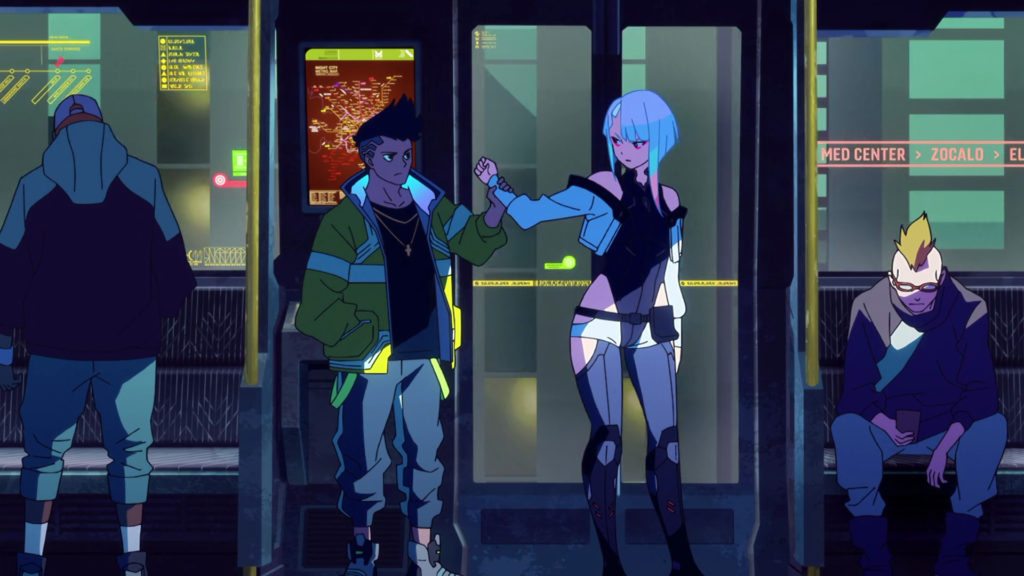 Cyberpunk Edgerunners – There’s an old, ongoing joke that anime studio Trigger’s over the top style, luscious animation, and dedication to each of their projects is just what anime needs… that they saved anime… and it’s not really a joke, because it is also true!
Cyberpunk Edgerunners – There’s an old, ongoing joke that anime studio Trigger’s over the top style, luscious animation, and dedication to each of their projects is just what anime needs… that they saved anime… and it’s not really a joke, because it is also true!
This show was seen as a weird, too long delayed afterthought cash in to the Cyberpunk 2077 video game. The game had suffered an extremely troubled production and had come out with so many bugs, crashes, slowdowns, and flaws that Sony took the drastic step of removing the title from its online store for several months while the worst of the problems were being fixed. The game was almost condemned to failed project status by gamers, so having an anime set in the same world come out more than a year later seemed very odd. But, yeah, Trigger did it again.
As something of a sidestory in the 2077 universe, Edgerunners follows a crazy crew of Cyberpunk mercernaries as they cheat and steal and hack and fight their way to success in a retro futuristic world that offers zero comfort or solace. You either go big or you die trying. Somehow, Trigger took this wild world and filled it with a new stories and new characters that are arguably more compelling that those within the game itself. Add in a stellar soundtrack and shockingly good animation and this show is an absolute winner. The show was so well received, in fact, that it pushed the game back onto the top of the internet’s most played charts for a few weeks more than a year after it had been abandoned by gamers.
So, once again, Trigger saved anime. Oh, and they saved gaming this time, as well!
All The Rest – You might notice this list is missing some of the biggest big name hitters. There’s Spy X Family, Chainsaw Man, and Kaguya-sama: Love Is War‘s 3rd season that I simply haven’t gotten to yet. Attack on Titan is in like part four of its final season and I don’t want to watch it until it is finished. And those are just the ones I can think of…
Yep. 2022 was a great year for anime!
